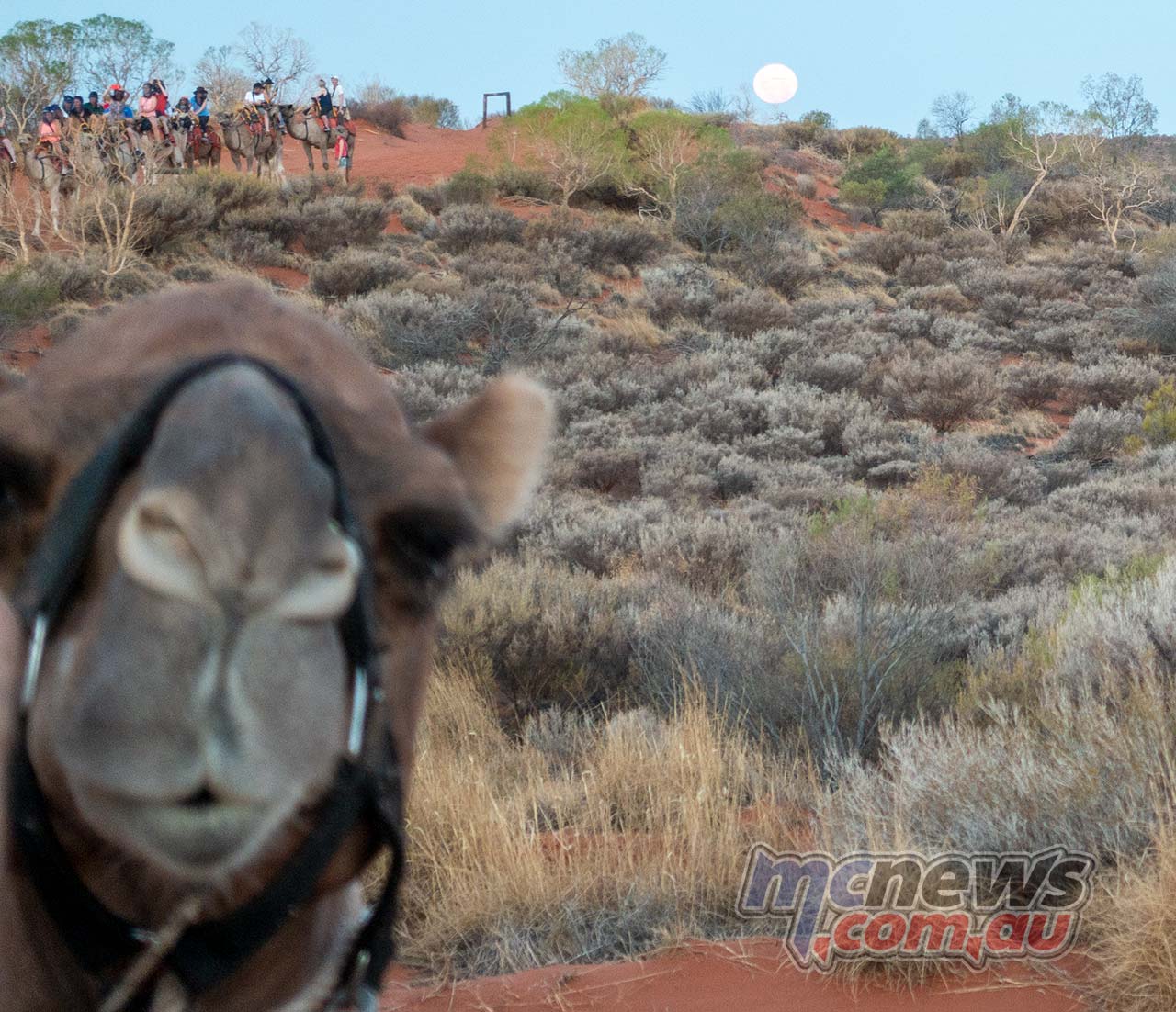2020 Honda CRF1100L Africa Twin Adventure Sports Review
When Honda first released the Africa Twin in 2016 it dropped into the market at an absolute bargain price point and, save for the optional DCT system, the CRF1000L was one of the simpler and more low-tech options in what is an increasingly crowded adventure bike market-place.
The relatively basic but very affordable $15,499 package was an instant hit and globally Honda have shifted almost 100,000 Africa Twins since the model was introduced.
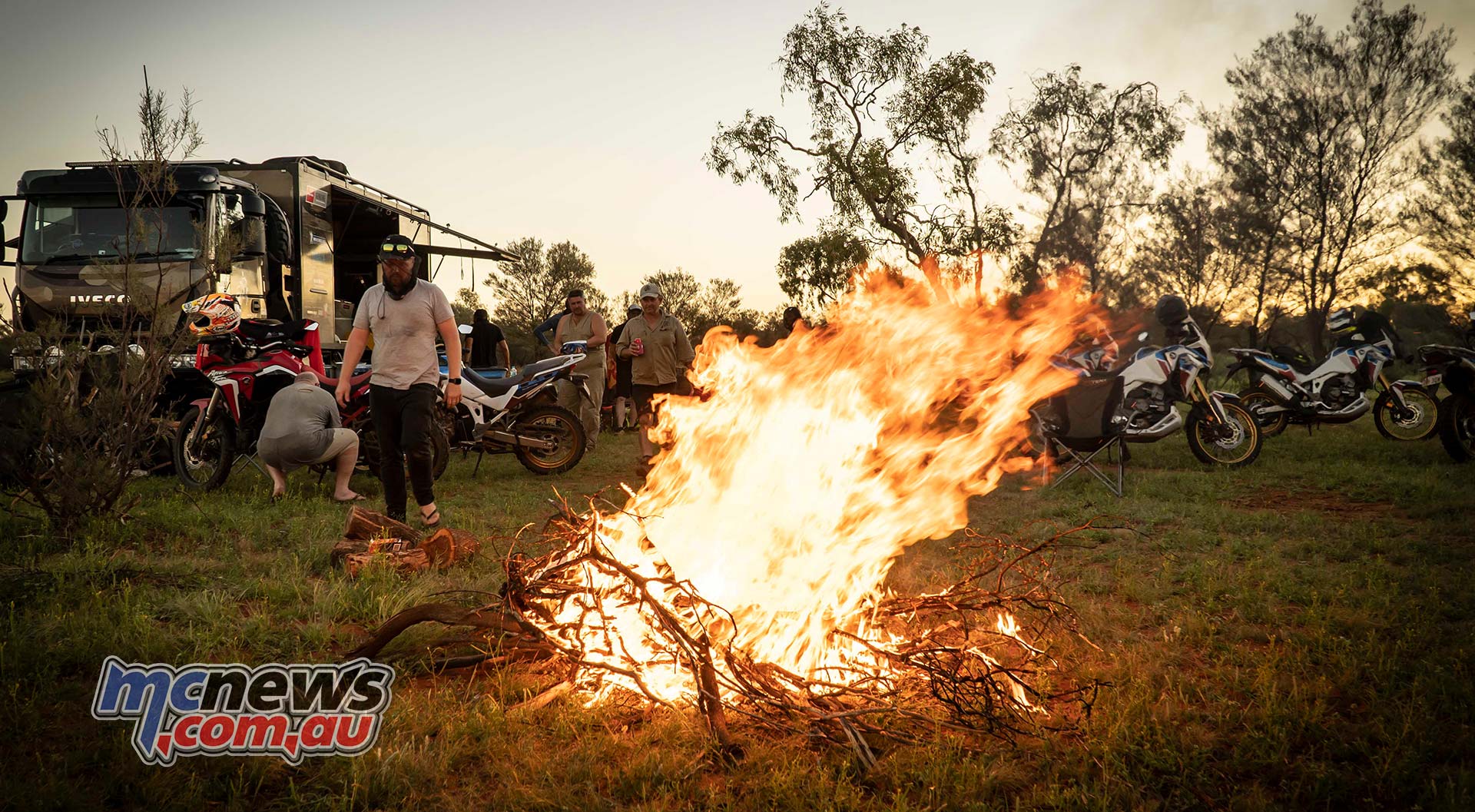
More recently a higher-spec Adventure Sports model was added, with a bigger tank along with a few more bells and whistles, and now for 2020 we have an all-new second generation Africa Twin range.
Lighter, nimbler, more powerful and with an extensive suite of top shelf electronic smarts to go with its boost from 998cc to 1084cc, the latest Africa Twin certainly pushes Honda’s adventure option to a higher level of sophistication.
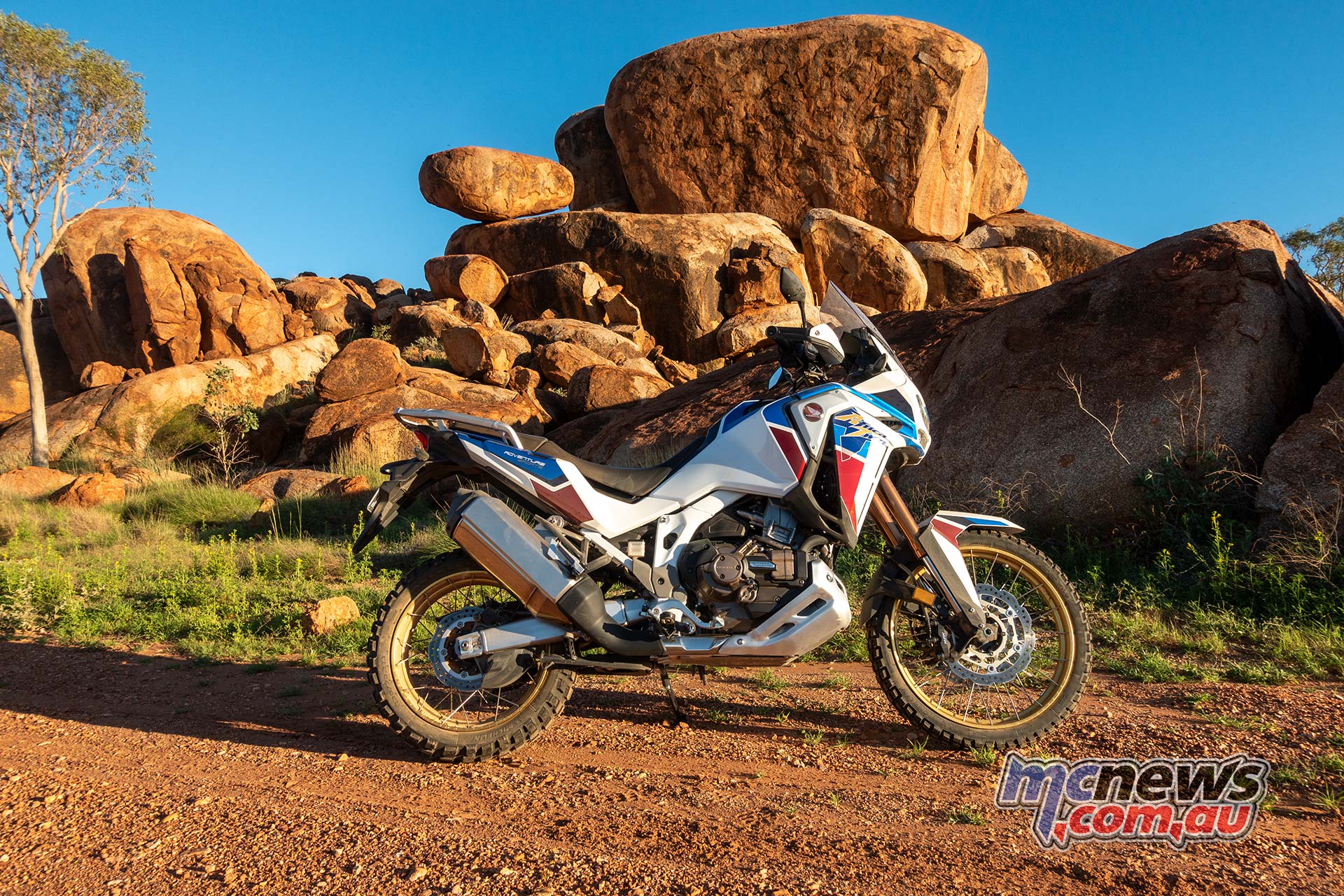
The price has also risen with the entry point now starting at $19,999. The larger Adventure Sports model retails at $23,499 with DCT adding another $1000. The range topping Adventure Sports ES, complete with excellent Showa electronic suspension, wears a $26,499 sticker price.
Honda Australia launched the much anticipated new Africa Twin with a major adventure ride through the Northern Territory staged by Daryl Beattie Adventure Tours.
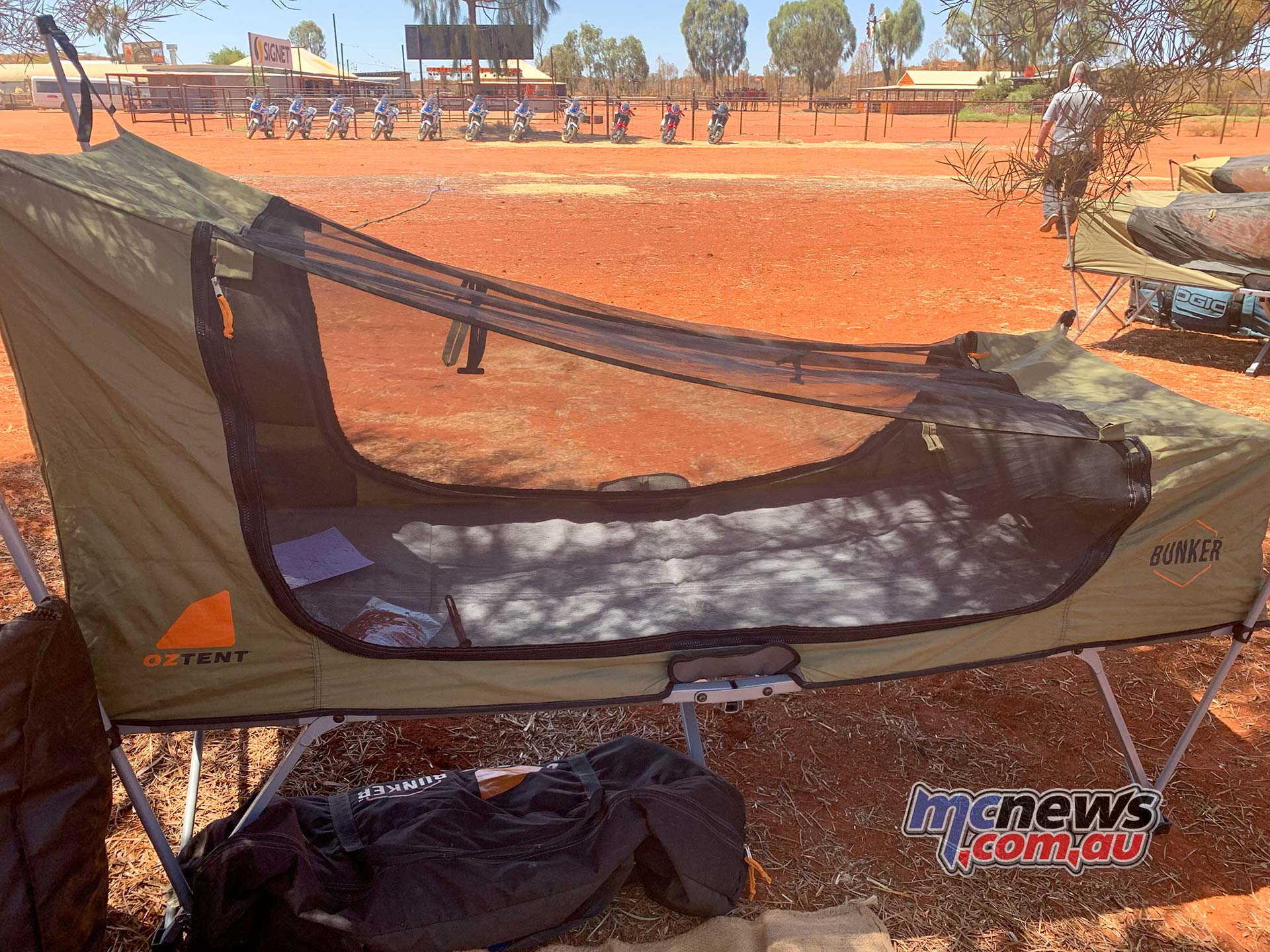
I chose the top of the range machine complete with DCT, just as I did during the New Zealand launch of the first model a few short years ago. On that launch of the original I also chose to ride a bike on the standard tyres complete with luggage, despite the vast majority of the riding being off-road. I wanted the worse case scenario, so to speak.
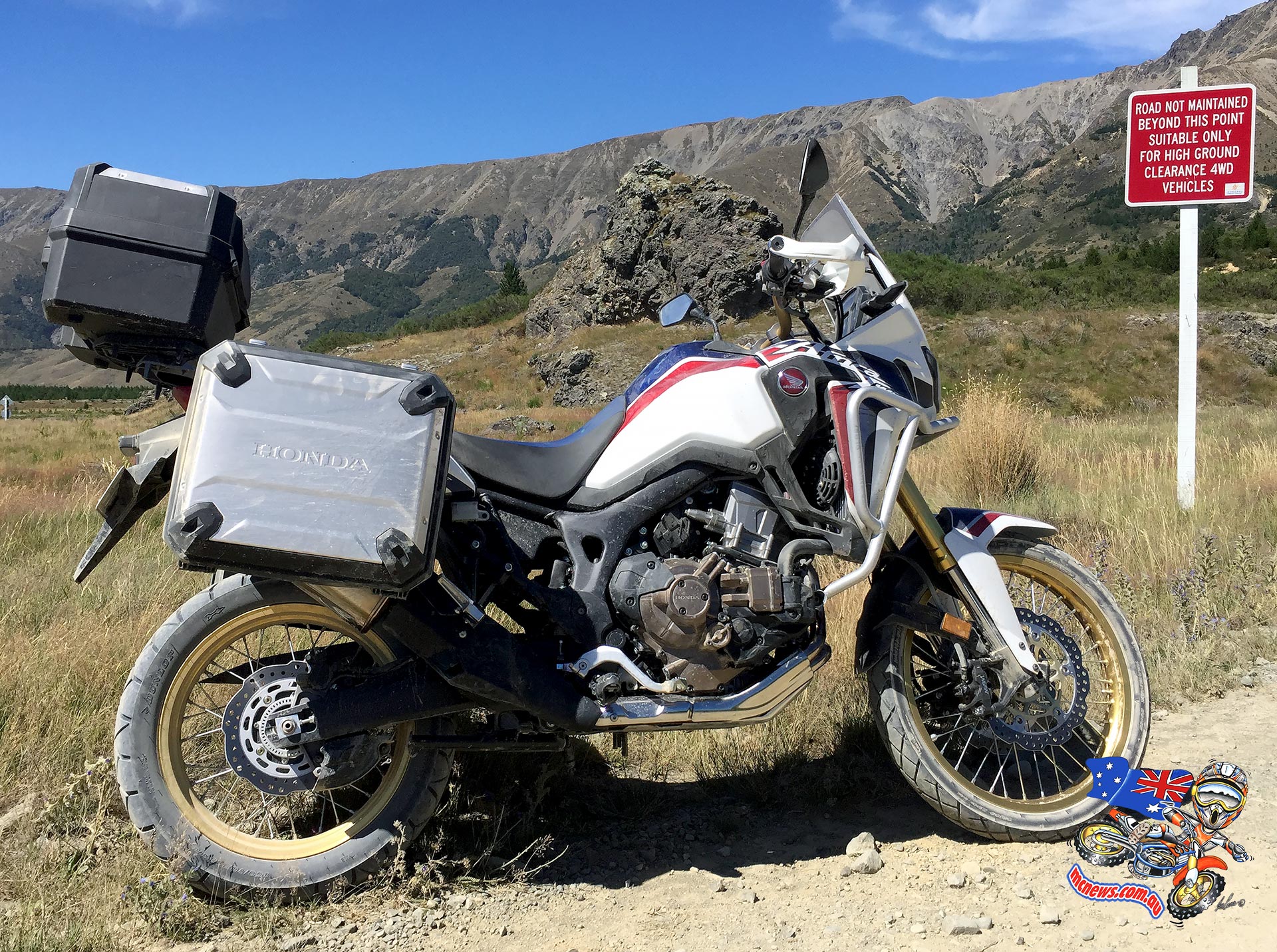
My Adventure Sports mount for the vast majority of this 2020 dalliance in the desert rode on the new Showa EERA electronic suspension. With the amount of sand work we were in for, the standard rubber had been replaced by more serious Michelin Anakee Wild. I ended up sticking to this machine for 95 per cent of the trip, only switching to the manual base model machine on the final afternoon. I also repeated the testing approach I used on the original bike, that is, let the bike’s electronics do their magic, while I just ride the thing.
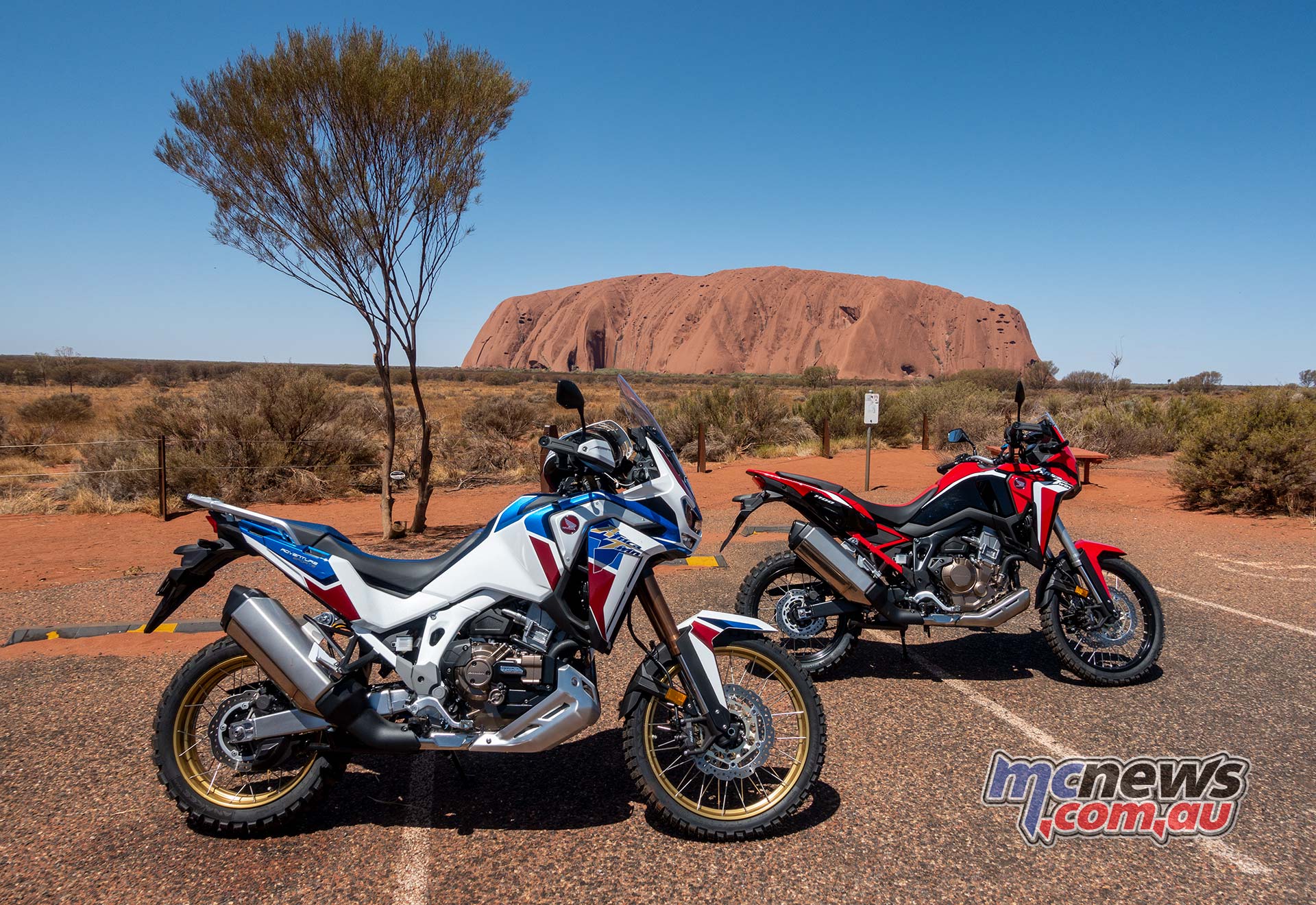
Through soft sand to mud and rock strewn floodways, I just let the DCT shift when it wanted and the other electronic smarts to do what they were designed to do. You can’t test this stuff by turning it all off once you hit the tough stuff! I put my trust in the bike and was handsomely rewarded.
Trust and confidence is never more needed than when faced with negotiating sand on a large motorcycle. Keeping the throttle on and speeds up, while atop a writhing beast pretty much wandering where it wants, is some real teeth/butt clenching stuff when you are not accustomed to riding sand all that often. Button off and you are in the shit. It really is a case of gripping the bike with your knees, leaning back and trying to sail across the sand, keeping the front light and the rear wheel driving, and the poo inside your bottom.
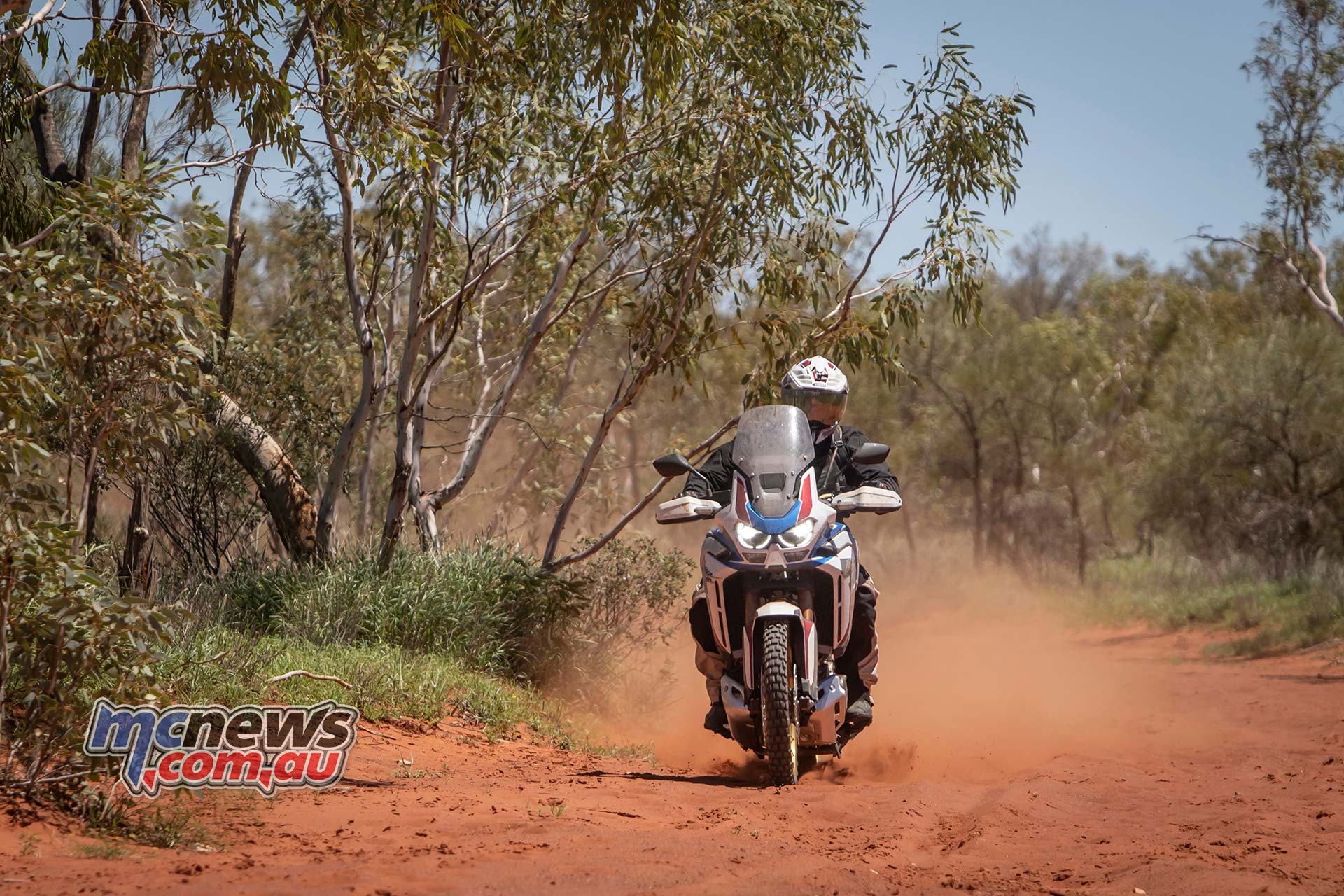
I am not one to make sort of blanket statements without rigorous back-to-back comparison testing, but in this case I am going to make an exception. The Africa Twin is simply the most confidence inspiring big adventure bike on the market. It’s stability and ability to keep tracking true, even when the rider had started to lose his composure, simply amazed me time and time again.
That big 21-inch front combined with some fairly lazy geometry sees the Africa Twin pull you safely out the other side of some seriously shitty situations. On more than a few occasions I was almost resigned to an inevitable upcoming face-plant, only for the bike to carry me through. I didn’t come out the other side of these scrapes with fist pumping jubilance, just a sigh of relief that I had made it. Time and time again that was thanks to the unflappable stability of the bike.
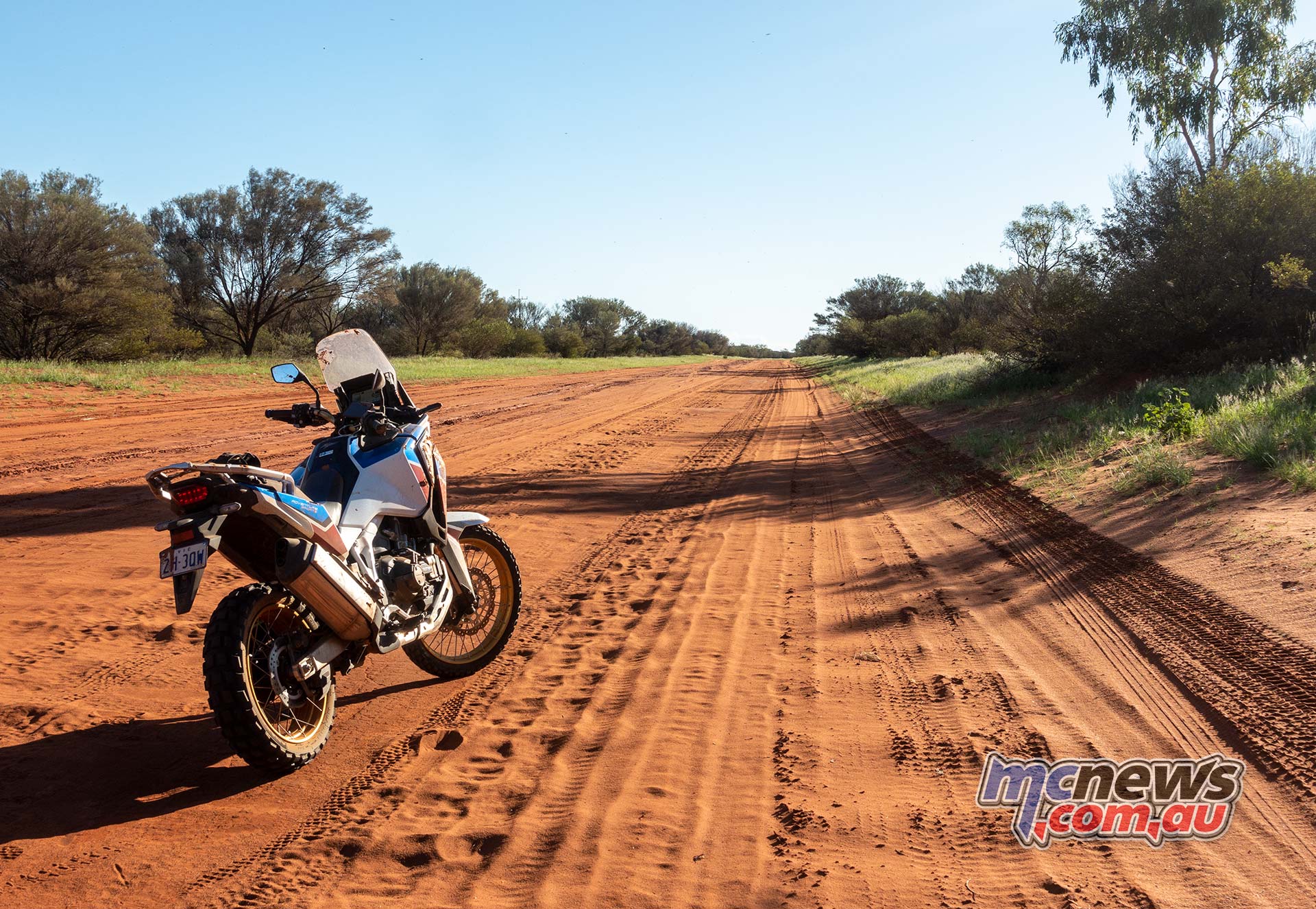
I remained steadfastly committed throughout the, at times very challenging, almost 2000 kilometre test route to evaluating the bikes smarts. The DCT was left to make the shifting decisions itself, the traction control and ABS in their most minimal intervention off-road settings, the electronic suspension set to off-road mode with no extra tweaking of the parameters, using all of Honda’s latest systems to their fullest and coming out the other side very bloody impressed.
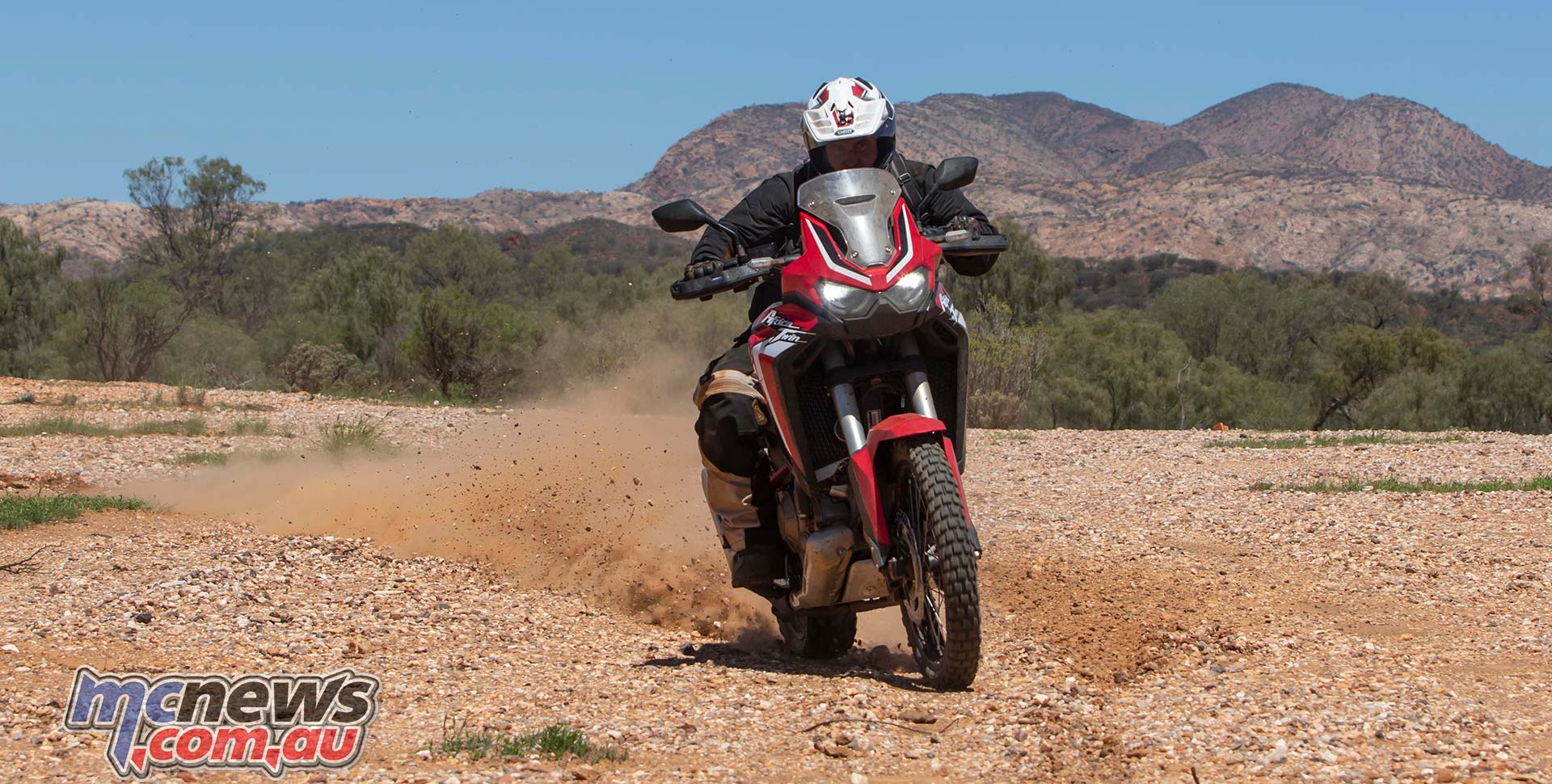
For sure, all these challenges could have been overcome on other options in the marketplace, but I feel 100 per cent confident in stating that this latest Africa Twin is the easiest to ride big adventure bike there is on sale today. If your off-road skills and confidence are not up to scratch, but you want the comforts and luggage capacity afforded by a large adventure machine, while still getting out and amongst serious terrain that will challenge your mettle, then you won’t do it easier on anything else.

It is fair to say that Honda have, in recent times, been more than a little behind the pace of electronic smarts seen on European machinery. No more.
The new Fireblade is now at the absolute extreme upper echelon of current motorcycle electrickery, and the Africa Twin now shares almost all the smarts that are seen on the $49,999 CBR1000RR-R SP. Including the top shelf Bosch six-axis IMU that equips the electronic systems with all the sensory inputs required in order to deliver one of motorcycling’s most sophisticated suite of rider aids.
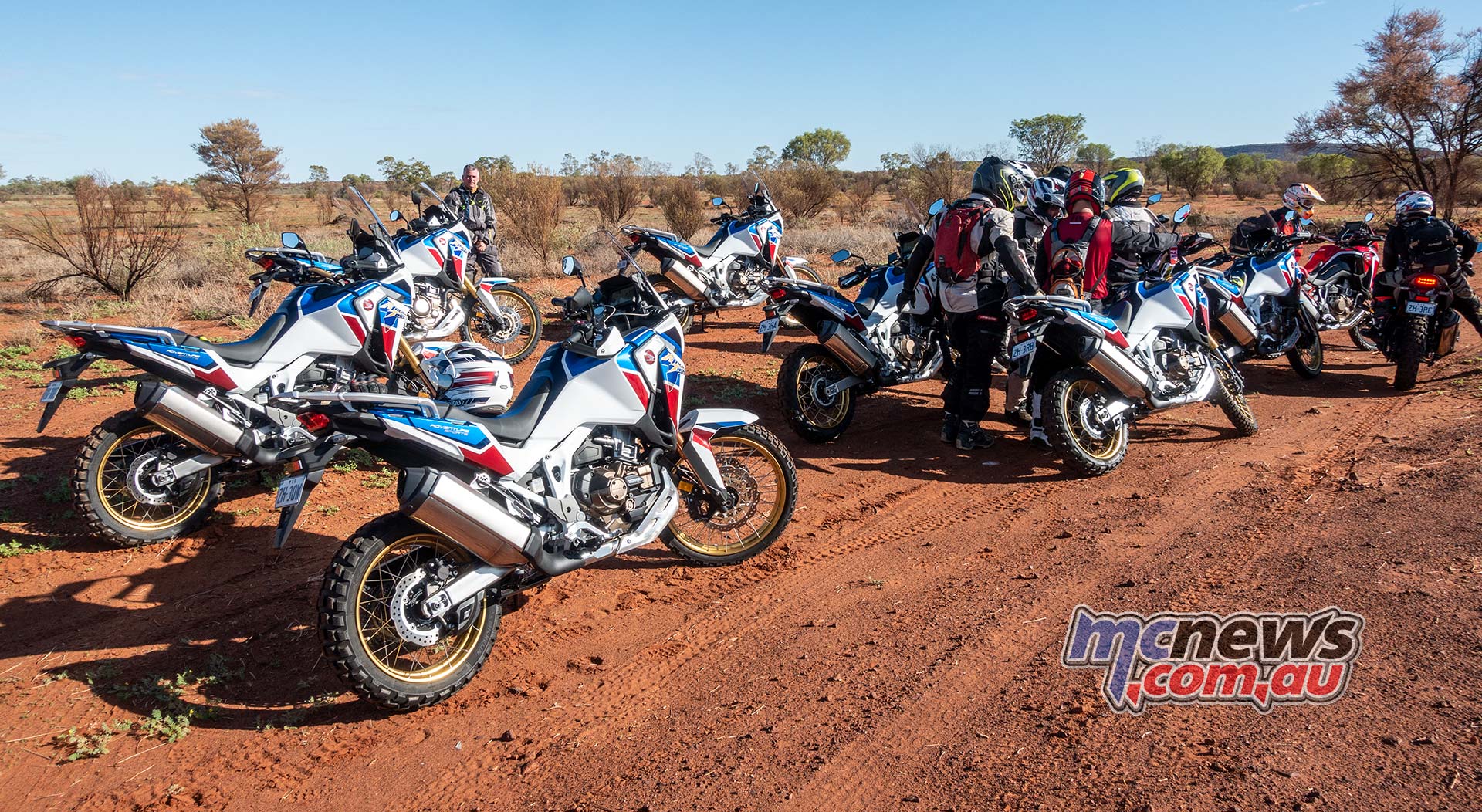
Even the DCT shift response now takes some of its cues from the angles the bike is transitioning through, which has helped to raise the self-shifter experience further. There are up-down paddles on the left bar, and you can even option up a conventional foot shifter if you must, but I never felt that need and instead let the ECU pick the gears throughout the whole adventure.
If trying a DCT out for yourself be sure to select one of the more sporting shift programs. If left in D for dumb then the machine shifts really early on the up-shifts, and is very slow to down-shift. Tweak the response up to Sport, which has three further sub-levels of aggression, of which I preferred the middle setting, and the down-shifts are much more urgent, the more brake pressure you use the quicker the system will shuffle down the gears. Most riders on the launch were from more of a dirt background, and thus generally use less front brake than I, and it was these guys that preferred to manually down-shift the bike when setting up for some corners as without those front brake inputs the automatic system is not quite as responsive.

Once you have tuned your own ECU, read brain, to how the system works, then it never catches you out by doing anything unexpected. It generally knows when you want to be feathering the throttle through a corner, and will then hold that gear until you return to a more upright and less aggressive stance on the bike, where it will then up-shift and resume normal operation.
The DCT pretty much does what it says on the box and does it very well. Around 25 per cent of the previous model in Australia were optioned with DCT and Honda have sold more than 100,000 DCT motorcycles globally. The technology is well proven and in this latest generation is excellent. The G mode for a more direct throttle feel via a quicker lock-up on the clutch packs is retained from the previous model and holds the lower gears much longer again.
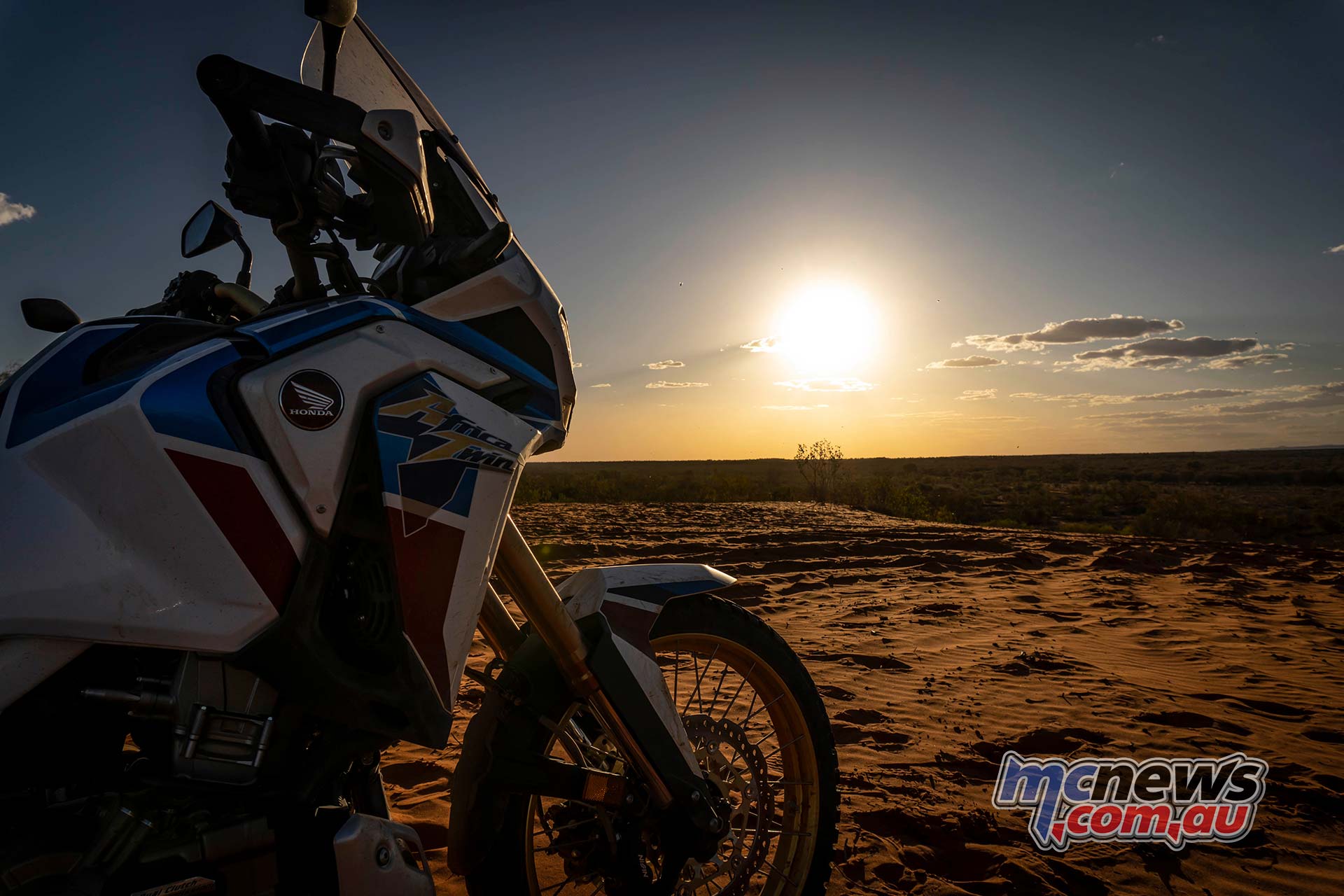
Despite the significant ten-kilogram weight penalty, you can probably tell I am a bit of a fan of the DCT, so is Daryl Beattie. Daryl has used previous generations of the DCT Africa Twin exclusively for many desert crossings in sand that most of us would struggle to ride a proper dirt-bike in, and he and his crew are now converts to the DCT bikes. More than once both himself and his Daryl Beattie Adventure Tours lead rider, Peter ‘Budda’ Luczkowski, have forgot to pull in the clutch when rolling to a stop on a conventional bike and almost gone down at walking pace as they spend so much time on the DCT bikes.
Daryl Beattie
“I’m really happy on both the Manual and DCT. The gearbox on the manual CRF1100 is really nice and a quick-shifter would compliment that even more. But if it’s down to a final decision then I really enjoy the DCT for all round commuting and adventure riding on weekends… make sure you select the correct DCT mode that best compliments the scenario you are in.”
The Africa Twin has now also gained the excellent Apple CarPlay integration first introduced with the latest Gold Wing model (link). I have used this system on the Gold Wing and for general road touring found it absolutely brilliant.
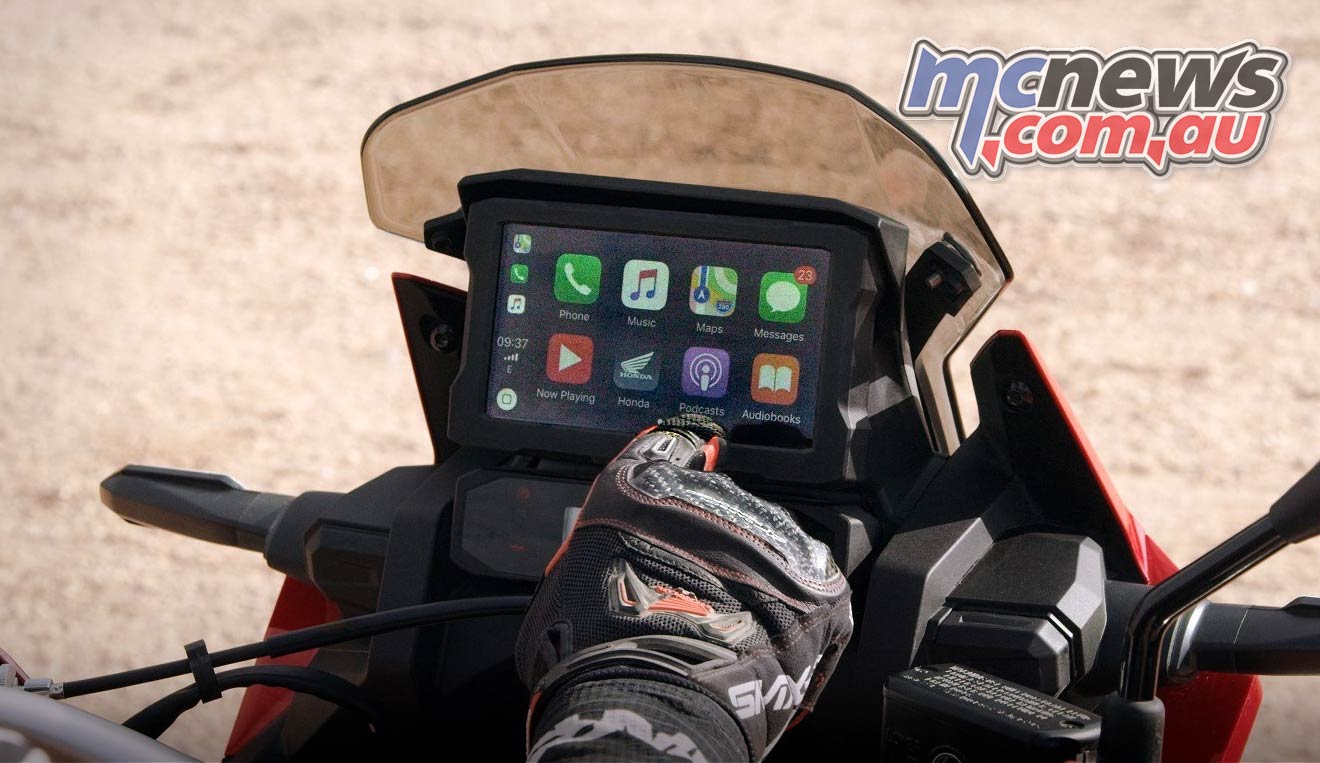
Unfortunately though, in order for the CarPlay functionality to be activated, a bluetooth headset must be paired to the system. I had no bluetooth system fitted to my Shoei adventure helmet so never got to use the CarPlay system during my time with the Africa Twin. Even when using a bluetooth equipped helmet, should your batteries in the bluetooth unit go flat, you then lose all the CarPlay functionality, including navigation. This shitted me no end on the Gold Wing, and frustrated me that I was not able to use the CarPlay system on the Africa Twin. Somebody come up with a hack for this stupid nanny state induced stumbling block please. Thanks.
The 6.5-inch touch screen display though is brilliant, and its functionality closely resembles that of the 5-inch screen seen on the latest Fireblade SP, just on a slightly bigger scale.
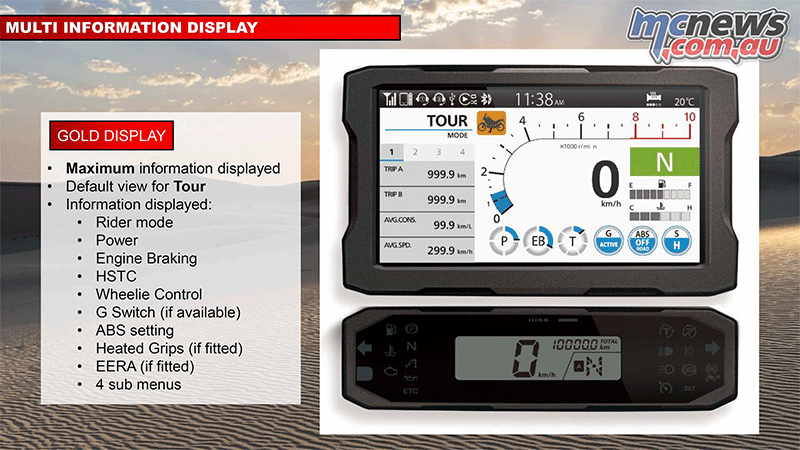
There are a myriad of screen lay-outs on offer and engine response (four levels), engine braking (three levels), shift programs, traction control (seven levels plus off), ABS (with on and off-road modes but only the rear can be switched off) and three-level wheelie control are all able to be separately tailored. It is the most comprehensive and customisable system of controls I have sampled and is navigated via a large switch-block on the left bar.

If anything it is perhaps a little too complex, but you can still just use the variety of pre-set modes if you don’t want to bother with delving too deep into the individual functions. It is simple enough if you want it to be.
There is a narrow greyscale LCD below the main screen that provides the most basic of information. While that quickly dusts up, the main colour screen is seemingly impervious to dust due to some sorcery in its chemical composition that somehow repels airborne particles. While the big screen can take a few seconds to get its shit together on start-up, the small screen is instantaneously awake and ready for action. I guess the small screen might stay functional too in the case of a big off where you smash the big unit.
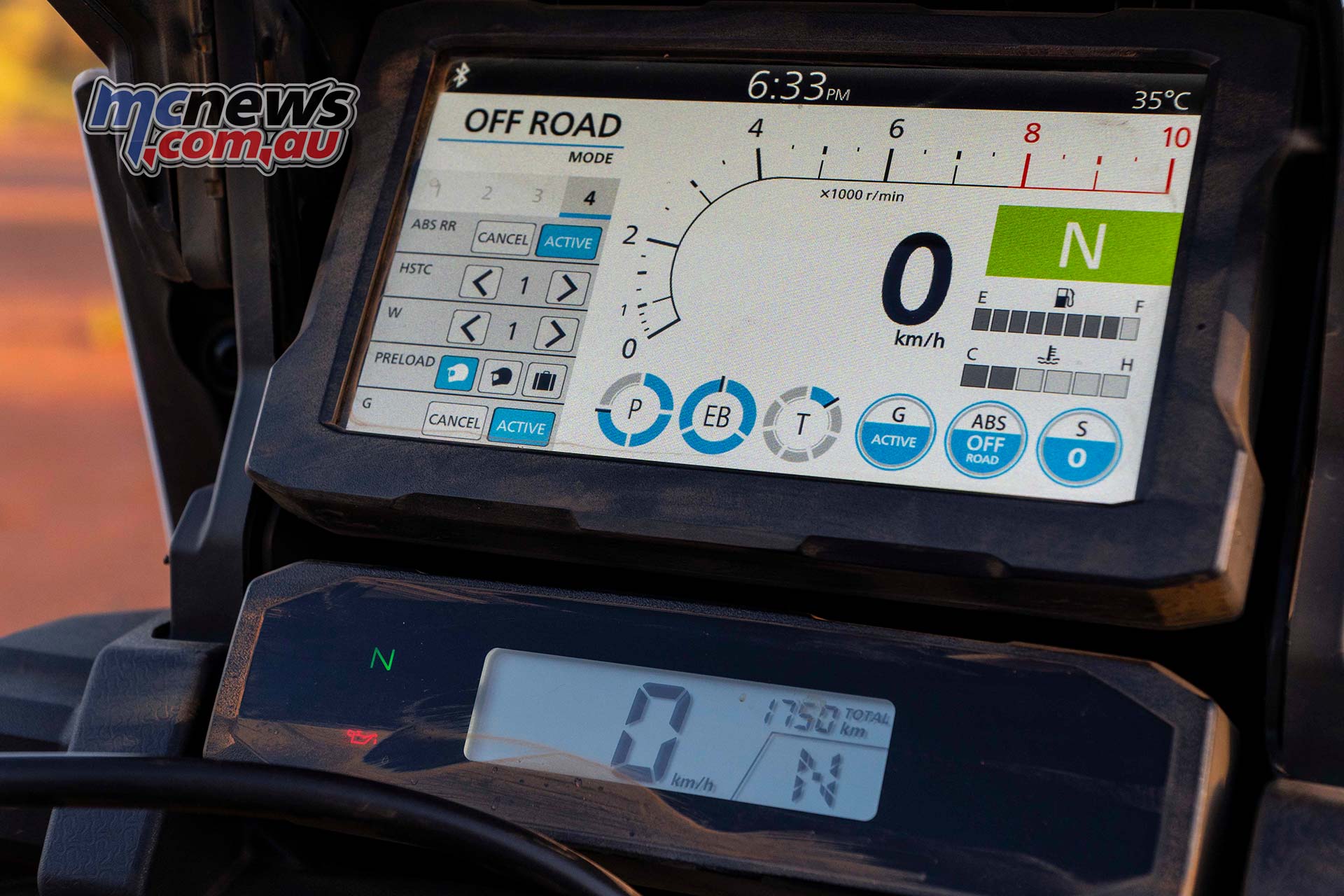
A well protected USB port is provided on both models with the Adventure Sports also scoring a merit style cigarette power adaptor on the opposite side.
The electronic suspension system does not automatically sense load and adjust pre-load to suit, but instead gives the rider the freedom to choose how much pre-load they want set on the rear suspension via the touch-screen menu and the bike then takes care of it. The electronic suspension adds two-kilograms to the weight of the bike in comparison to the also quite high-spec’ fully-adjustable conventional Showa kit.
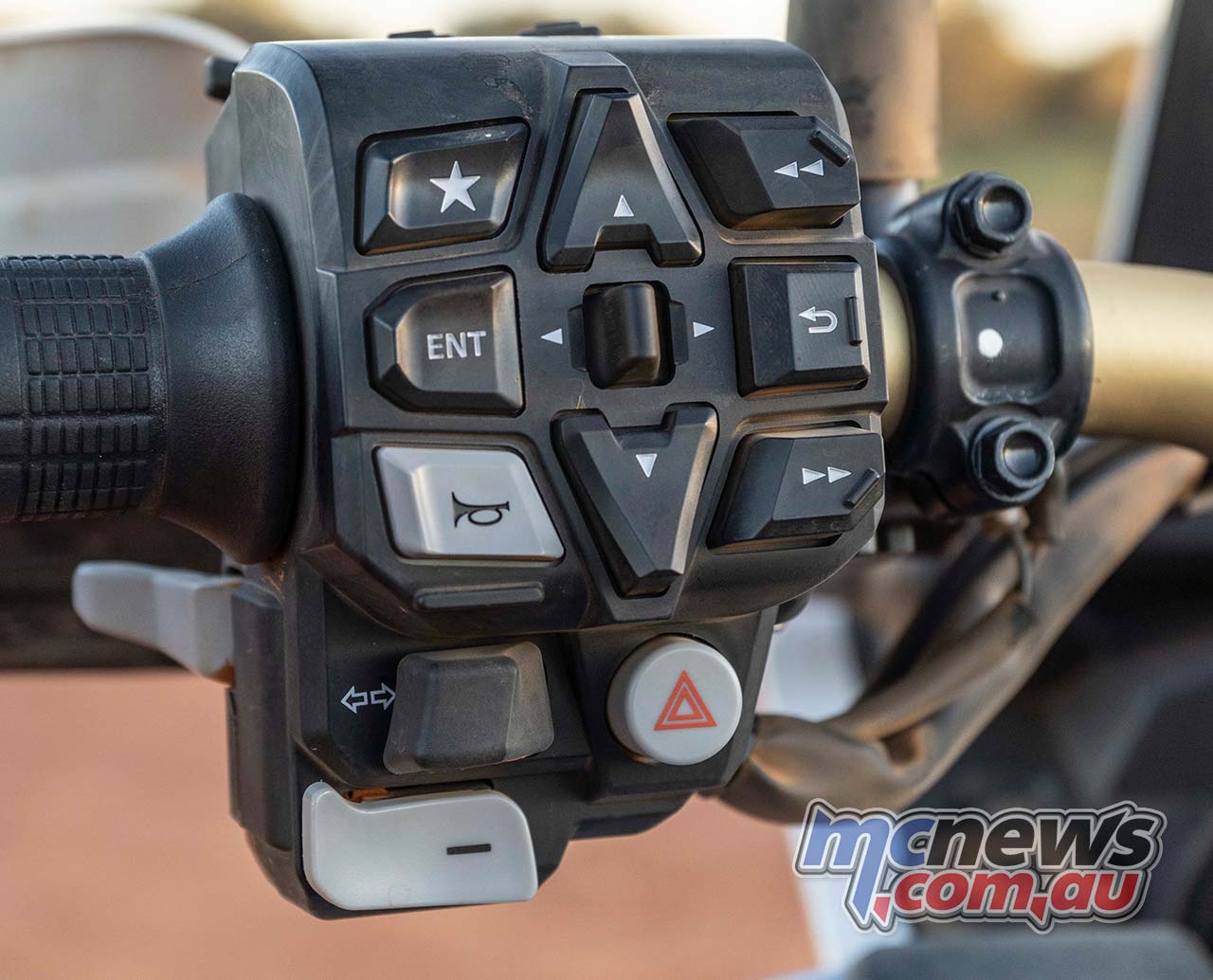
There are four default modes for the suspension damping response, Soft, Mid, Hard and Off-Road. These settings are for both ends of the bike and are further customisable through 24-steps in each mode. As we were predominantly off-road throughout the 1750 kilometre adventure I left the system in the off-road setting at medium, but after eating too many pies I did set the pre-load to rider and luggage to allow for said pie weight.
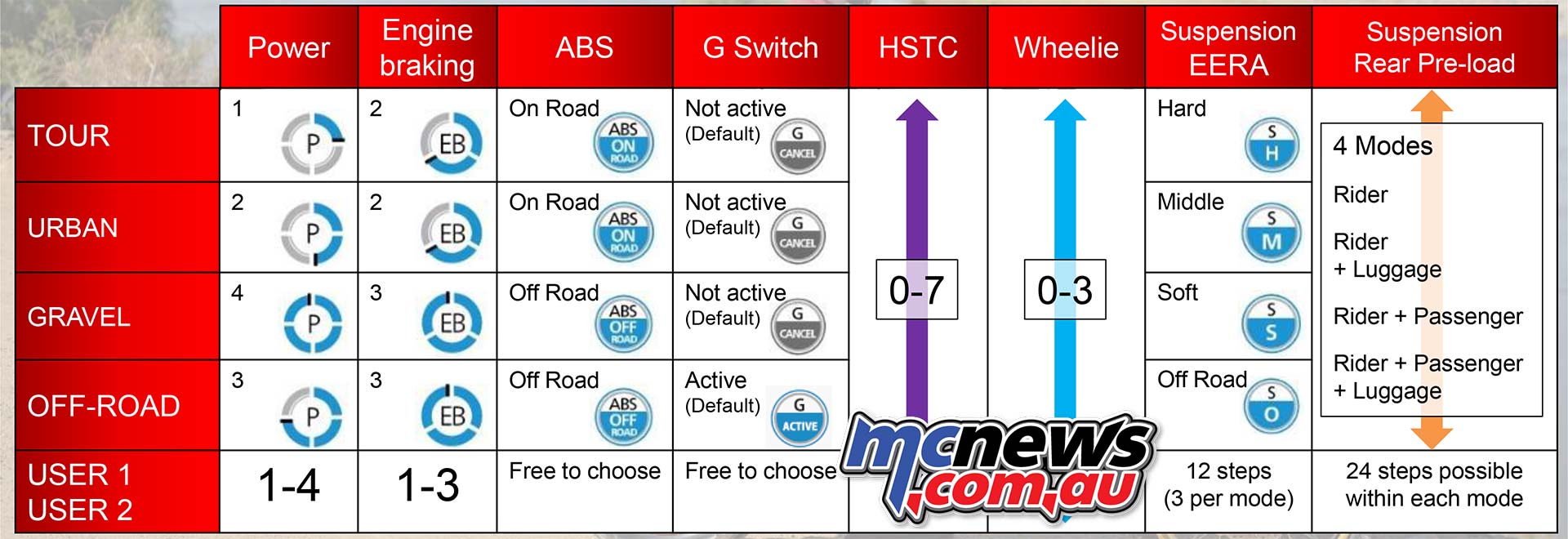
The damping response is controlled on the fly every 15 milliseconds (0.015s) on information derived from suspension stroke sensors along with vehicle speed and a myriad of other information such as throttle position and brake pressure etc. It even detects when a jump is being made and firms up both ends ready for the landing. I didn’t do any jumps as I fear that no system can cope with landings as ungraceful as mine, this white boy can’t jump and all that.
I have a fair bit of experience with most electronic suspension systems on the market and have ridden on pretty much all the progressive generations of Sachs and Marzocchi ESA systems used across BMW models, and also the WP systems used by KTM and Triumph. I reckon that while the Showa set-up on the Africa Twin feels stiffer in response than most, it also perhaps feels the most natural and linear in its damping response.
The Africa Twin boasts a huge 250 mm of ground clearance and the suspension strokes through a generous 204mm at the front and 220 mm at the rear. They’re pukka off-road specs.
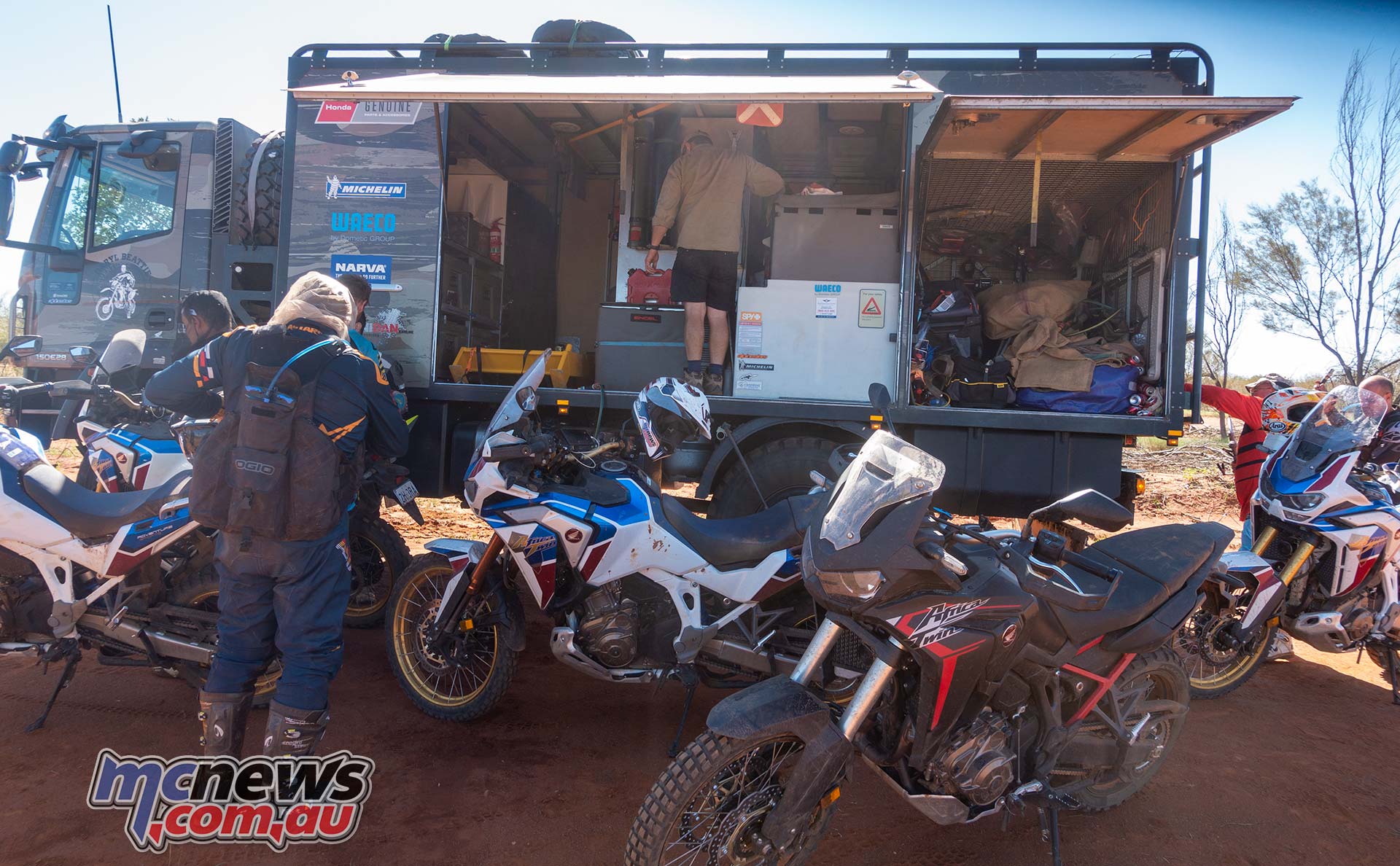
A major benefit with all electronic suspenders is the aforementioned ease of tuning that really comes into its own when touring. As you take luggage on and off the bike or leave your pillion at the motel room while you head off for a fang your preferred set-up is only a couple of button presses away. The manually suspended bikes do offer a hand-wheel for rear pre-load though that does add a little user friendliness to the conventional suspension experience.
I must quantify my experience here though by saying that I am yet to ride the Africa Twin in anger on tarmac. I will arrange to remedy this in the near future by getting my hands on an EERA equipped CRF1100L shod with decent road rubber to see how it performs under duress along the rigours of something like the tortuous series of turns that make up the fabled Eildon-Jamieson Road. I will report back after I have, but I think this is where perhaps the electronic suspension will really earn its $2000 price premium and prove worthwhile for those that really like to have a decent crack on the black-top.
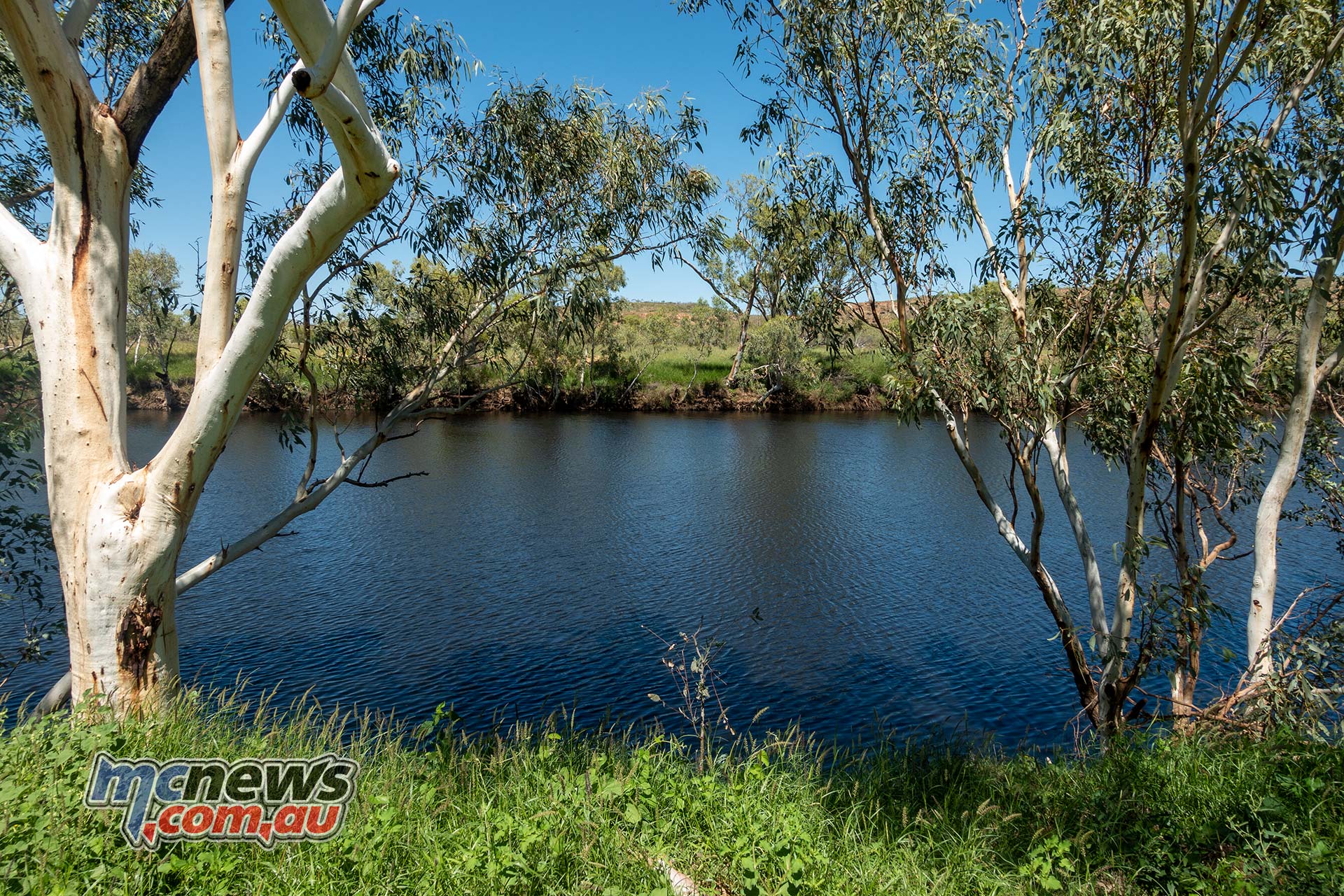
It will also be interesting to see how much agility Honda have traded to gain the amazing levels of stability that the bike enjoys off-road. I did play around with some tight low-speed manoeuvres with the steering on full lock, in which the machine did well, but am keen to see how well the machine holds a line on the tarmac. The frame is completely new and the chassis design is much more off-road focussed than before, right down to a swing-arm that is modelled from Honda’s CRF450R motocross machine.
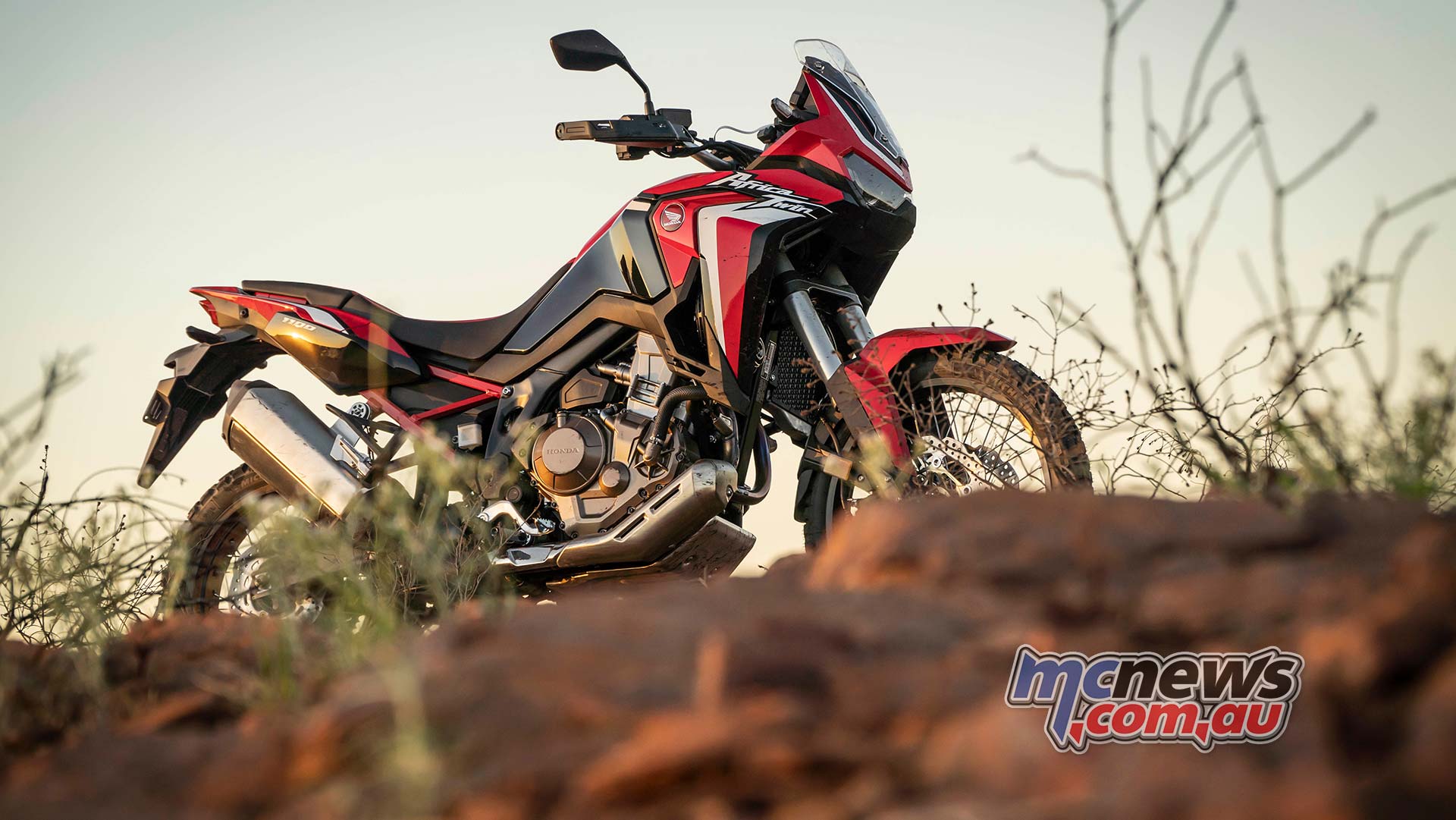
Likewise, while the braking performance and response was great off-road, I am yet to see how the stoppers cope with a full load of luggage heading into downhill tarmac bends. Its pretty safe to say though that Honda has that base well covered with radial four-piston Nissin calipers clamping 310 mm disc rotors.
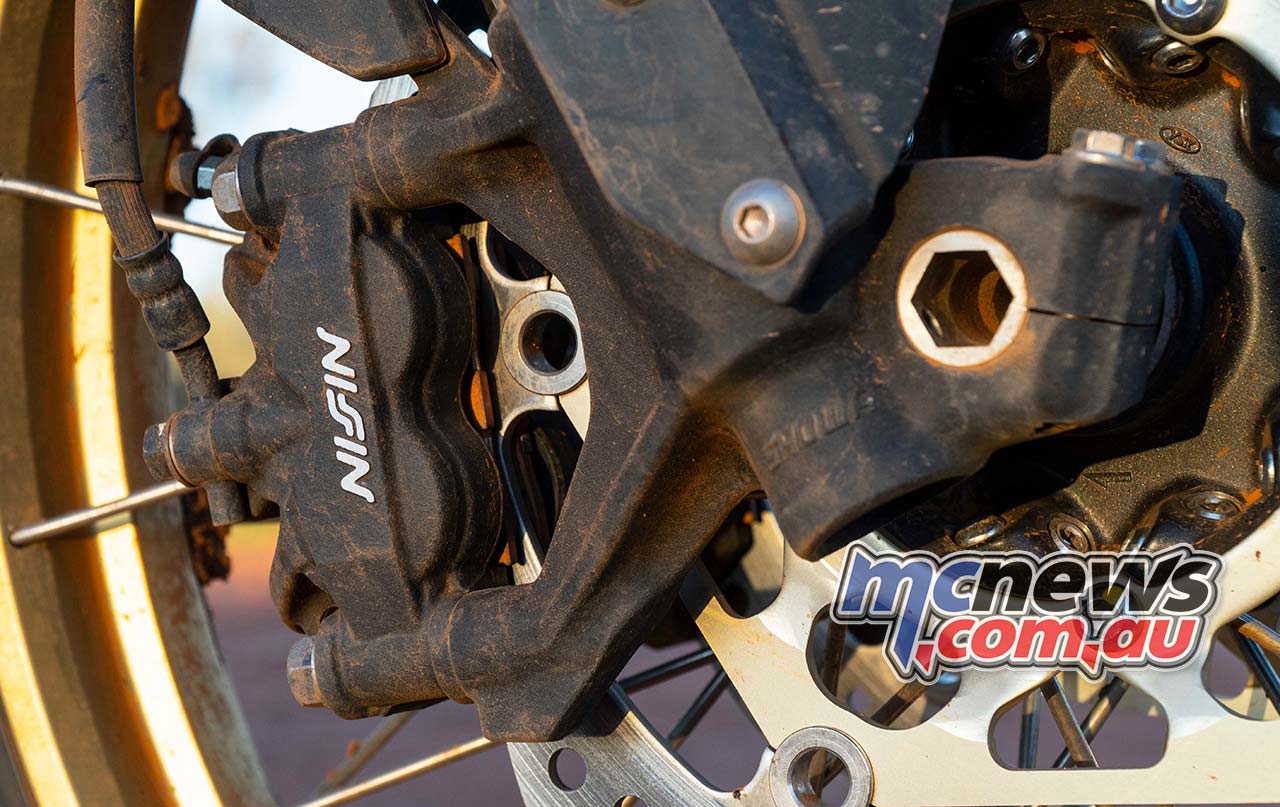
What some people might see as a distinct disadvantage for long-distance touring is the lack of shaft-drive. It must be said though, that riding the Africa Twin reminded me of how much nicer chain-driven bikes ride corrugations and rough terrain.
Good chains have long service lives these days and after initial break-in are very unlikely to require adjustments between rear tyre replacements. There is also no need to clean and lubricate modern chains all the time with most research suggesting that leaving them be, within reason, returns better results than covering them in lube that just picks up more dirt.
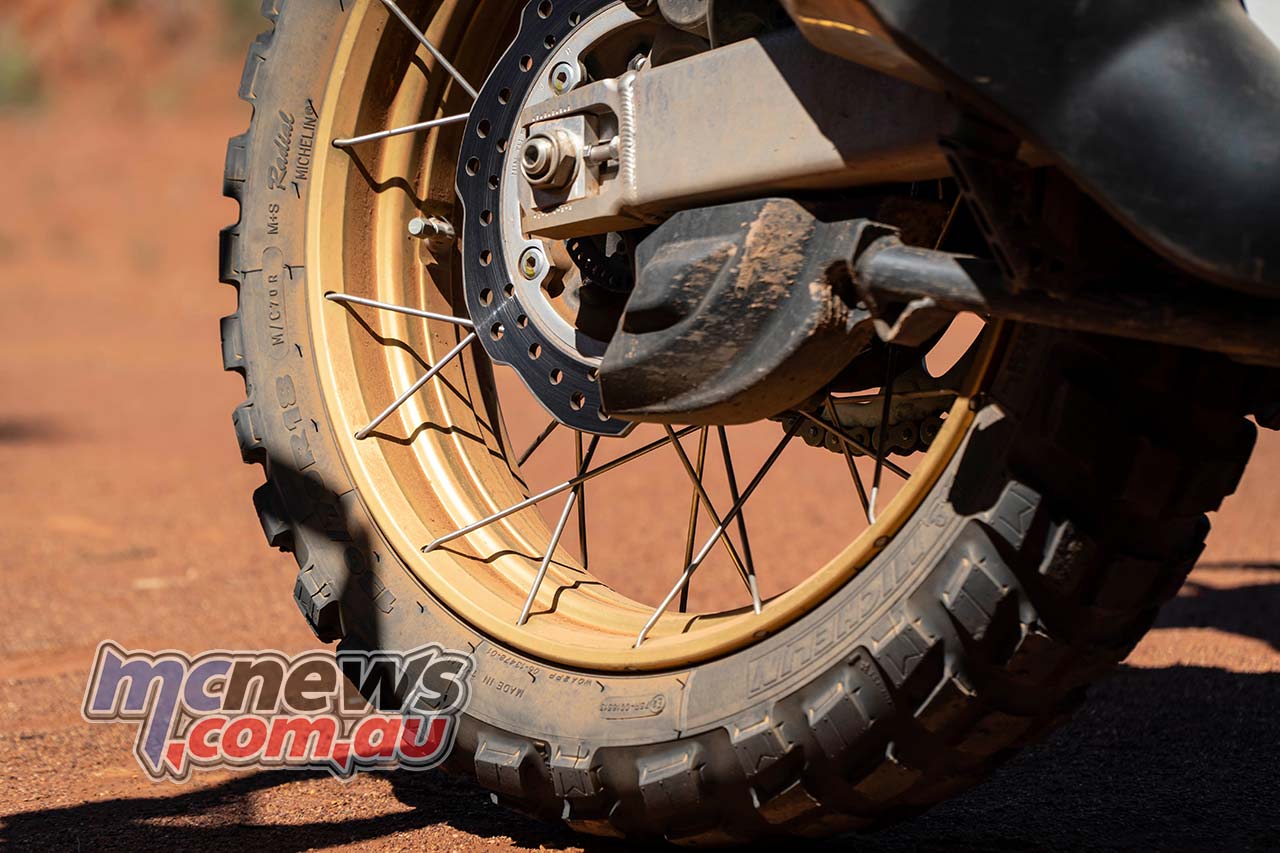
The Adventure Sports model rides on tubeless tyres while the more minimalist model has tubes. Most adventure bikes tread the middle ground and ride on a 19-inch front to retain their sporting potential on sealed surfaces but with all Africa Twin models riding on a 21-inch front, and similarly off-road specific 18-inch rear, it is clear as to where the design priorities of the engineering teams were focussed, they’ve got dirty minds…
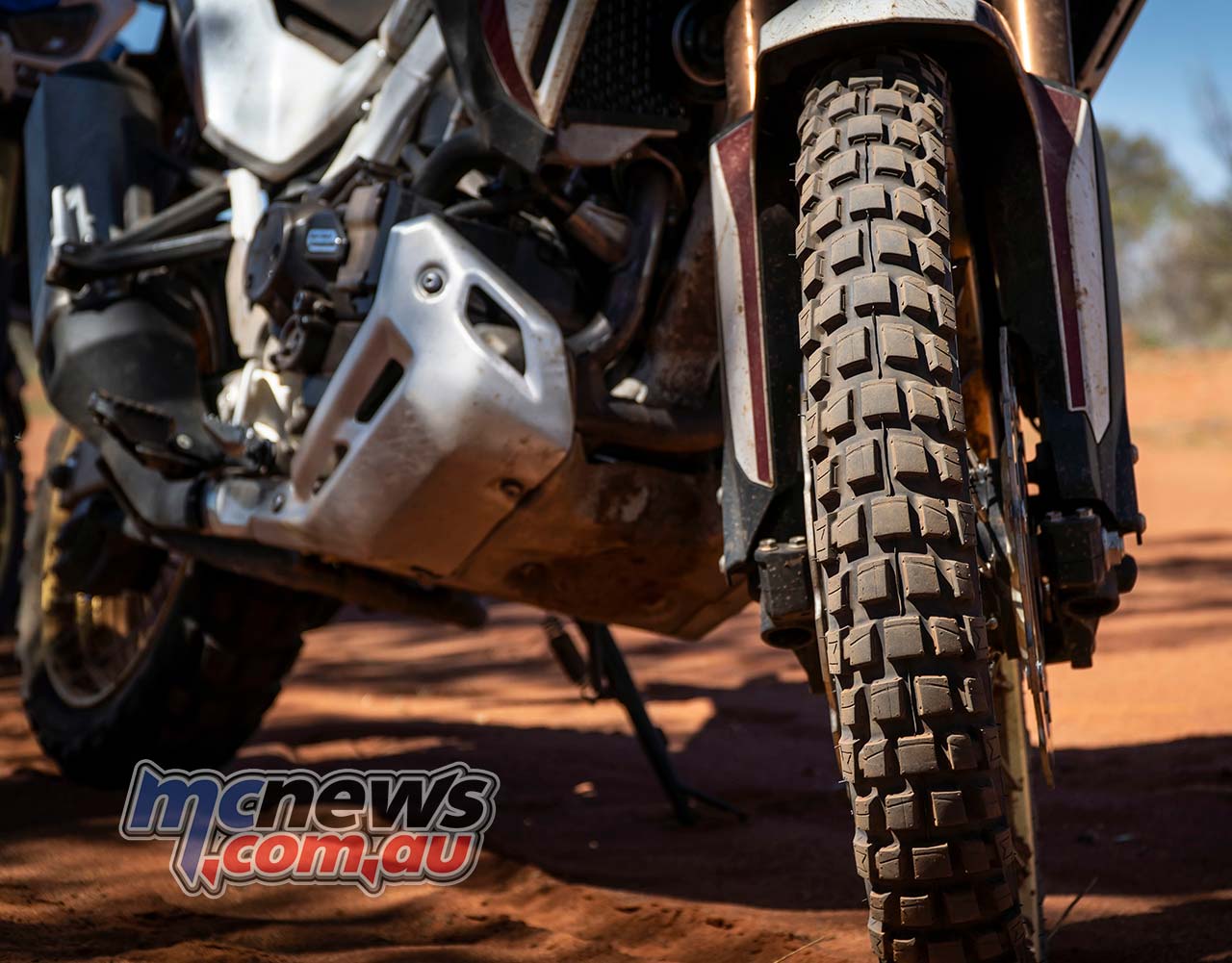
This is also no doubt why Honda has not endowed the bike with the massive power numbers boasted by the European opposition. Those figures are definitely up in the new model though, with power increased by seven per cent and torque up six per cent. Combined with a four-kilogram weight saving over the previous model, that adds up to an overall ten per cent better power-to-weight ratio.
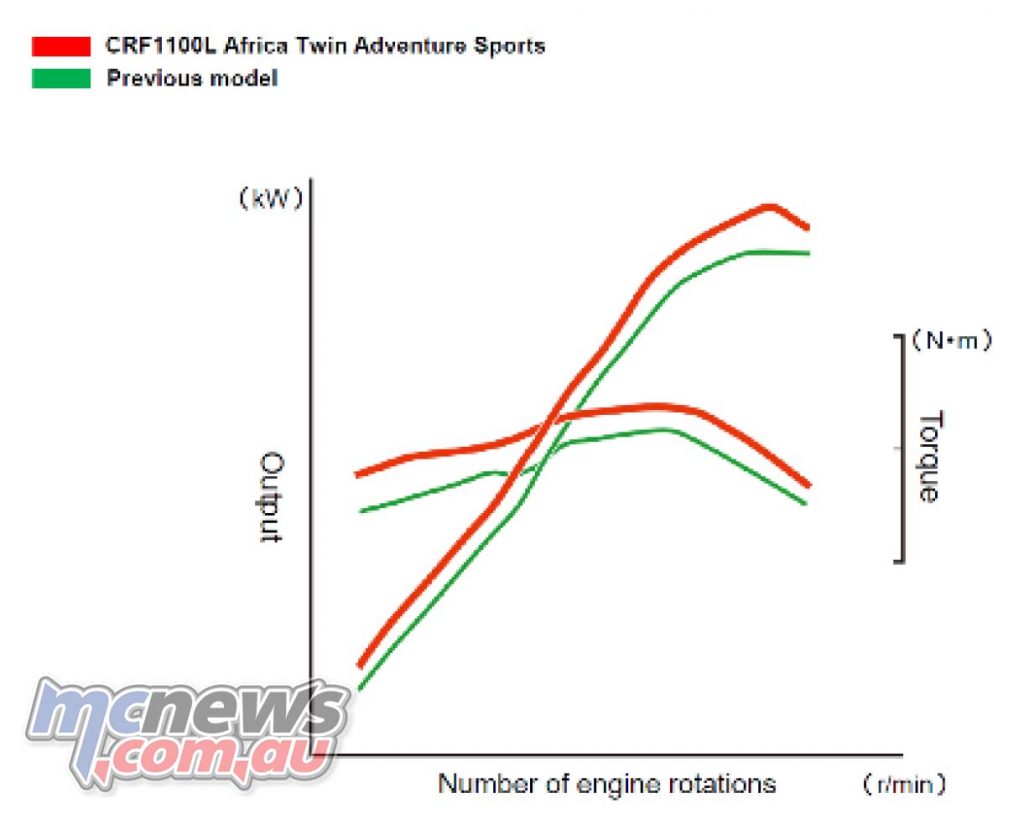
The boost from 998 cc to 1084 cc is achieved via a lengthened stroke from 75.1 mm out to 81.5 mm. Claimed power is an even 100 horses in the old scale with 105 Nm of torque peaking at 6250 rpm. The new engine is Euro5 certified and has been comprehensively redesigned while the larger 46 mm throttle bodies are actually much more compact than before and deliver their mix through larger valves that are lifted higher.
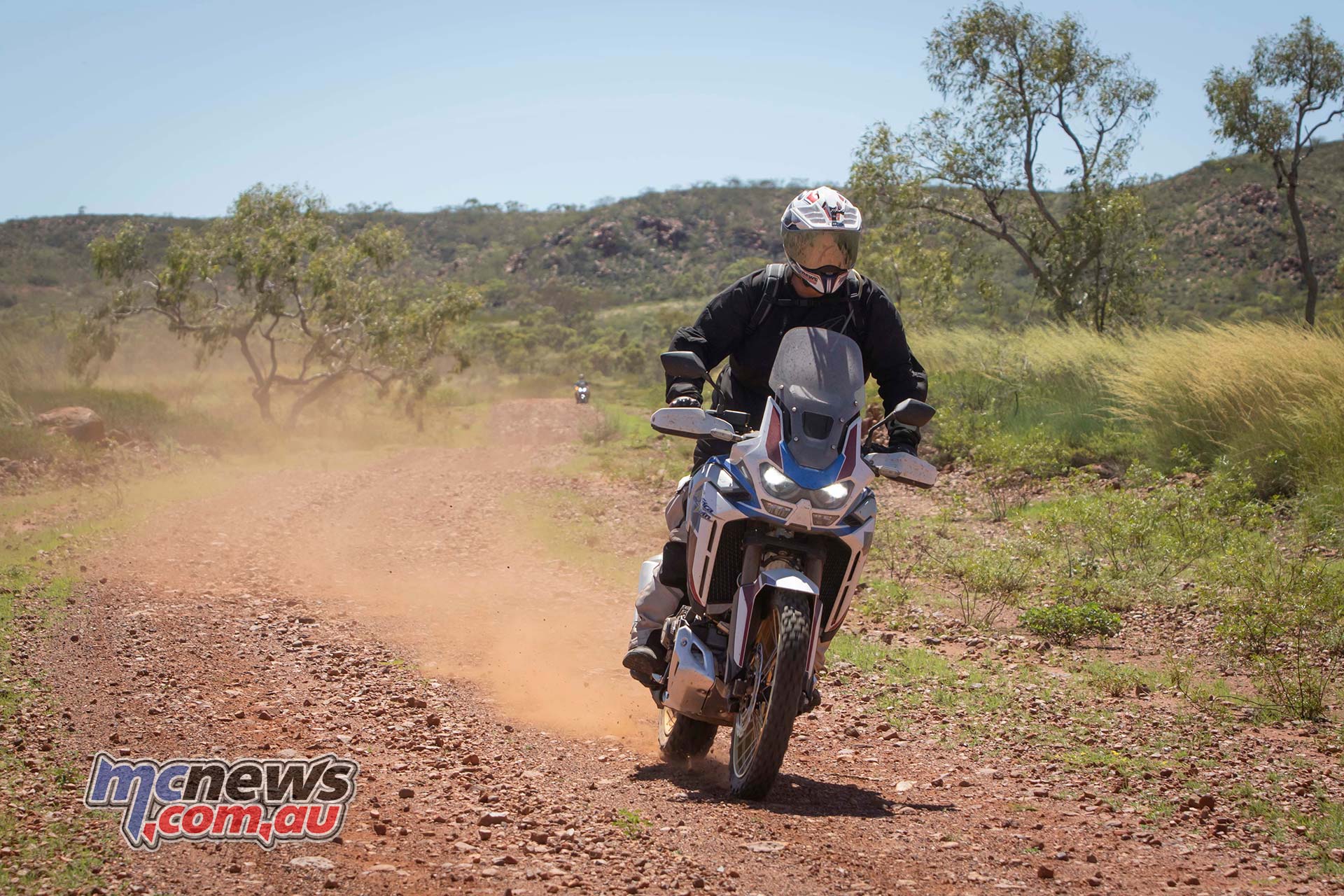
The difference is appreciated throughout the rpm range and the response from a closed throttle to pick-up is markedly improved. This is particularly noticeable on a DCT bike where you can’t ride a clutch against the rear brake for feet-up full-lock turns, in these scenarios the new model is far easier to control.
While the bike sounds great as you ride by onlookers, unfortunately that aural pleasure is never really appreciated from the cockpit. That’s a bit of a pity as it would certainly add a little more to the riding enjoyment if you could hear that really nice exhaust note while you ride.
The Africa Twin purrs along at around 3300 rpm when cruising at 100 km/h and the NT speed limit of 130 km/h sees the parallel twin turning over at 4200 rpm. The bike gets to 200 km/h quick enough.
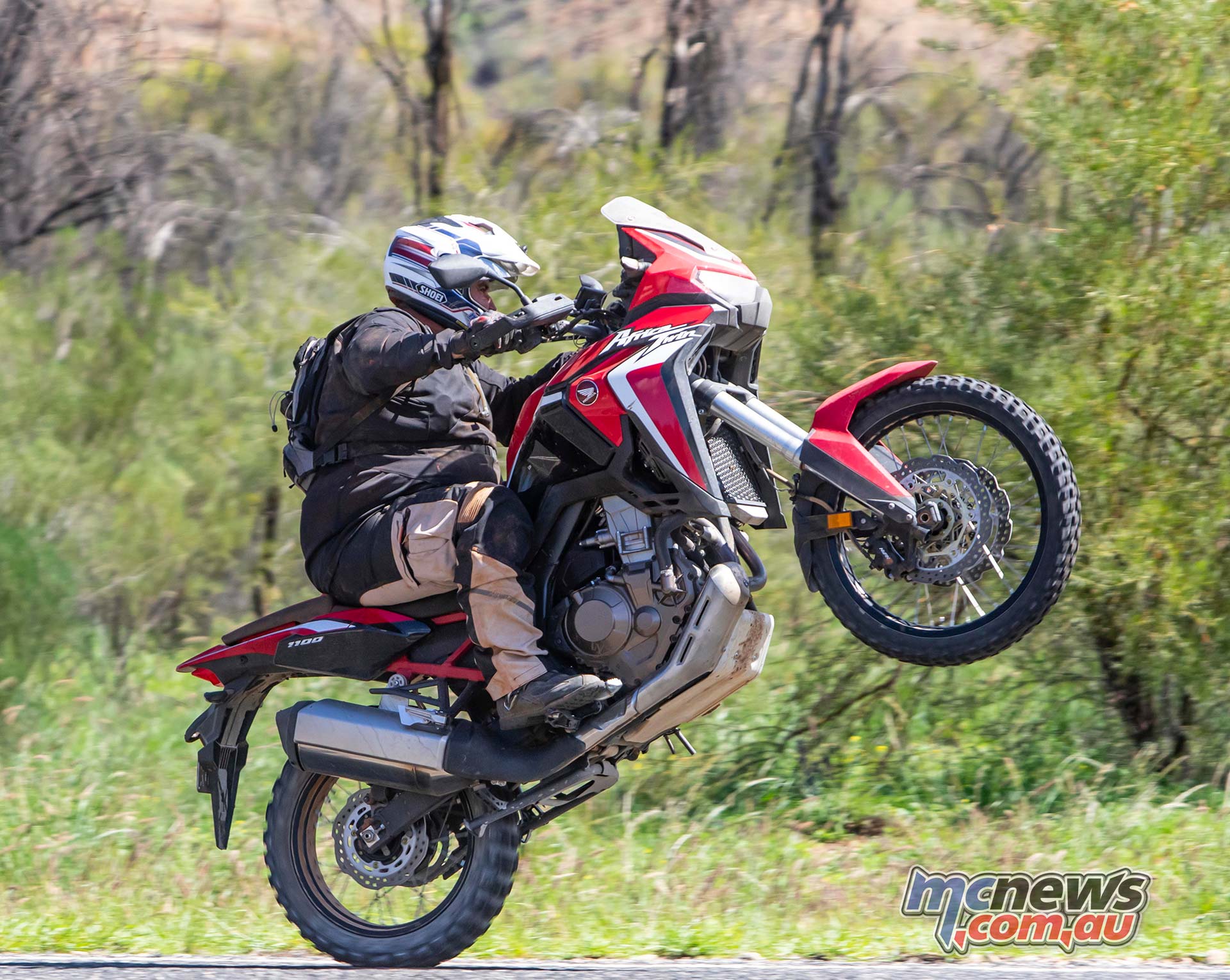
Despite being generally somewhat of a horsepower fiend (what me…), I never once wanted for more power during this particular adventure. That’s obviously because it was predominantly off-road and all three days were fairly taxing, thus energy conservation was key. I am generally a poor adherent to the needs for hydration but with temperatures nudging 40-degrees even I was needing to replenish my drained camelbak halfway through the day.
We were out in the desert good and proper with no phone reception, no shops and no real creature comforts. It was a swag come night time which coincided with the shift change as the flys handed over their duties to the mosquitoes who pulled the night-shift.

I lost count of how many flies I either swallowed or inhaled through my nostrils. Along with the whole Coronavirus thing going around I thought for sure we had also walked into some biblical pestilence that signalled pending armageddon.
The most comfortable place to be was actually astride the Africa Twin. I did have some reservations at first as the thinned down seat started to bite a little when halfway into the opening 920 kilometre day.
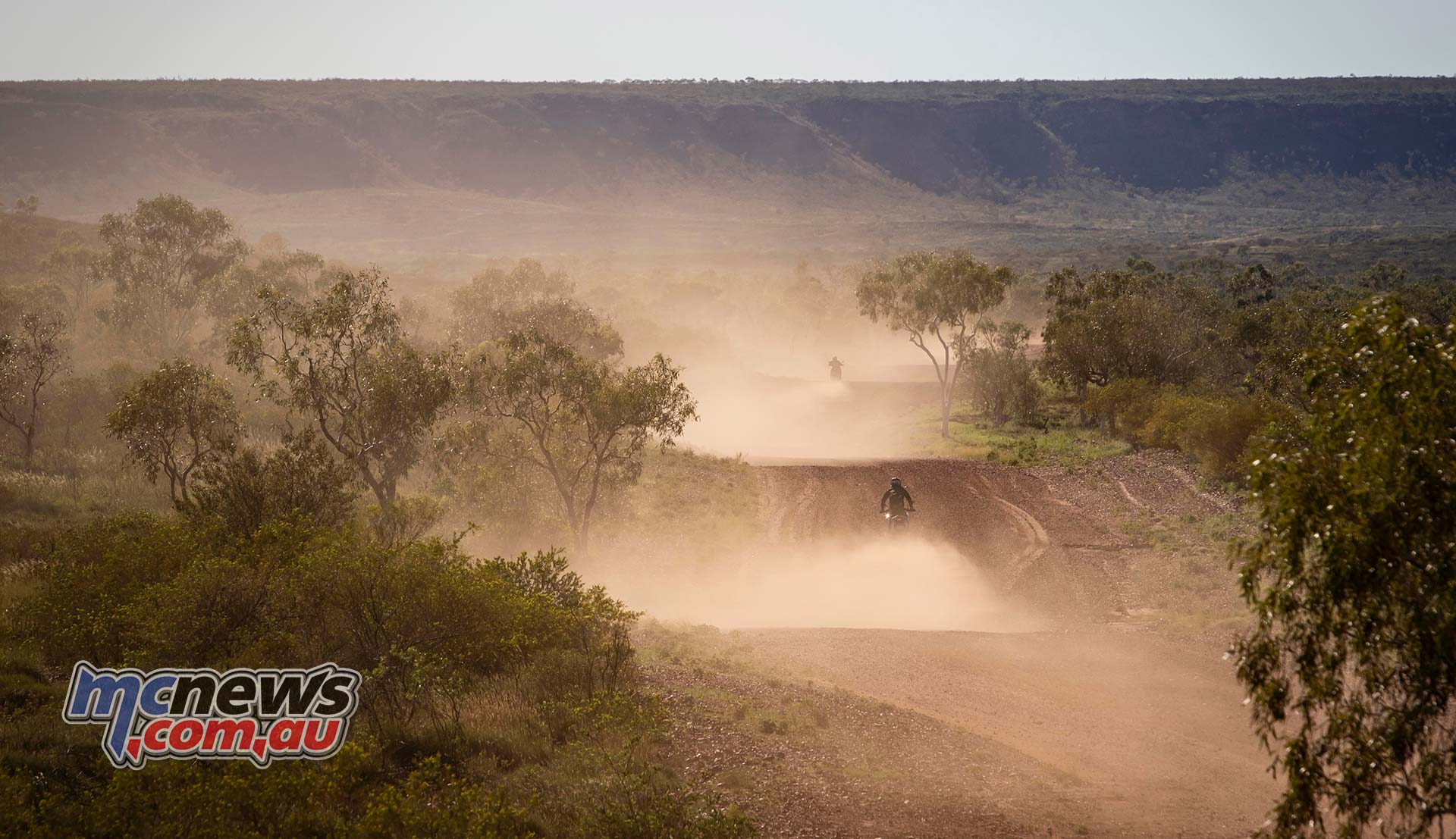
It never got any worse though and in fact I was so busy trying not to die on the following two days that it was not butt comfort that was front of mind, but instead more the integrity of my pooper valve, less I shit myself from yet another challenging rock and gravel strewn floodway interspersed with sandy drops in and out of said floodways. The area had recently recorded record unseasonal rains and some of the tracks were in pretty unusual shapes after big movements of subsoil and detritus.
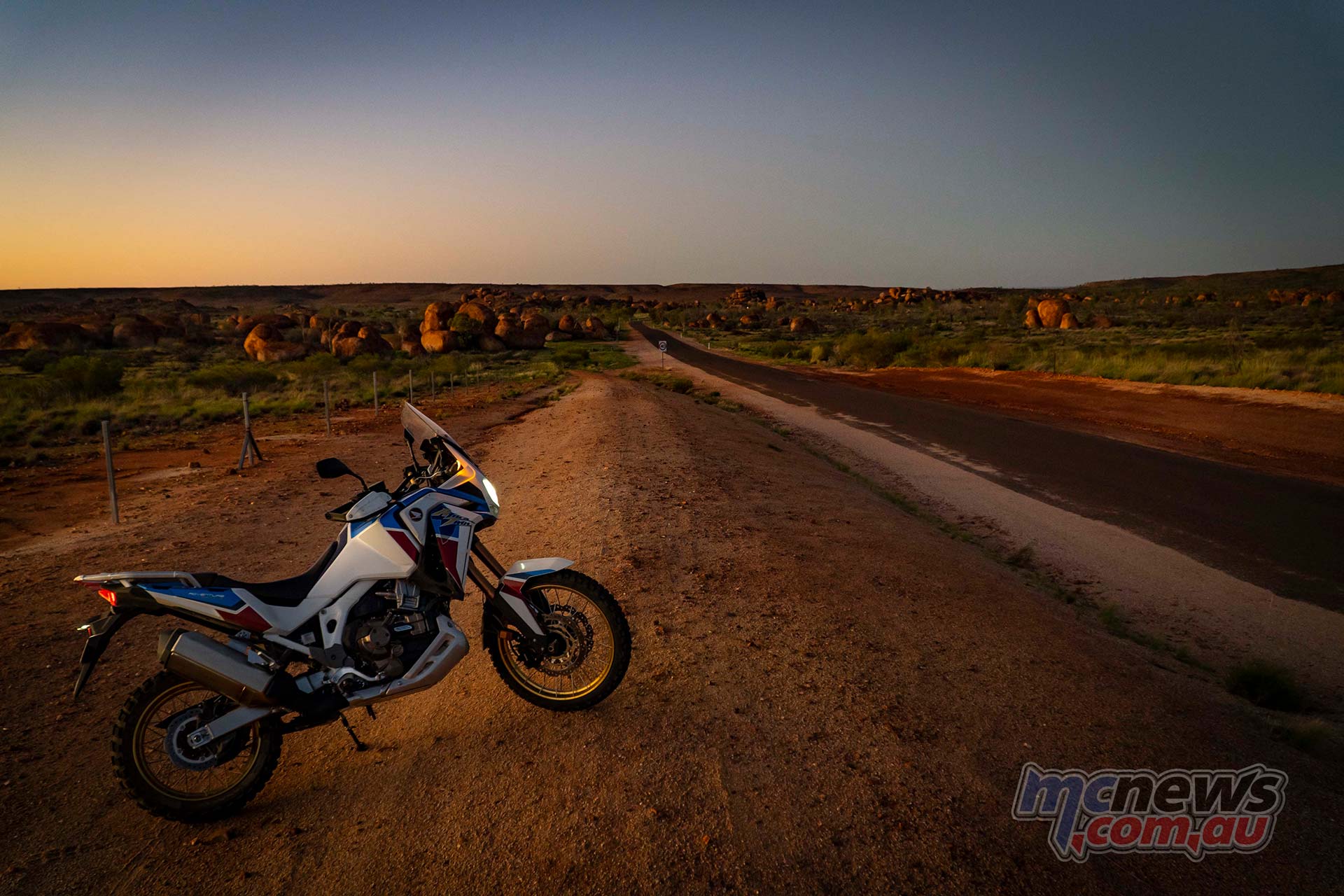
Getting on and off the bike is also much easier than before, something that is particularly welcome in the Adventure Sports. Honda spent a lot of time trimming where they could to make climbing aboard the bike a less dramatic experience for most folk.
Our lead rider Budda is only 164cm, that’s five-feet four-inches in the old scale, and struggled to get on and off the previous model but can now mount the new model much more comfortably. At 850 mm the seat of the Adventure Sports is a massive 50 mm lower than before, while retaining that huge 250 mm of ground clearance and generous suspension travel. The seat is also 40 mm narrower and that adds to yet more amenity that can be appreciated by all.
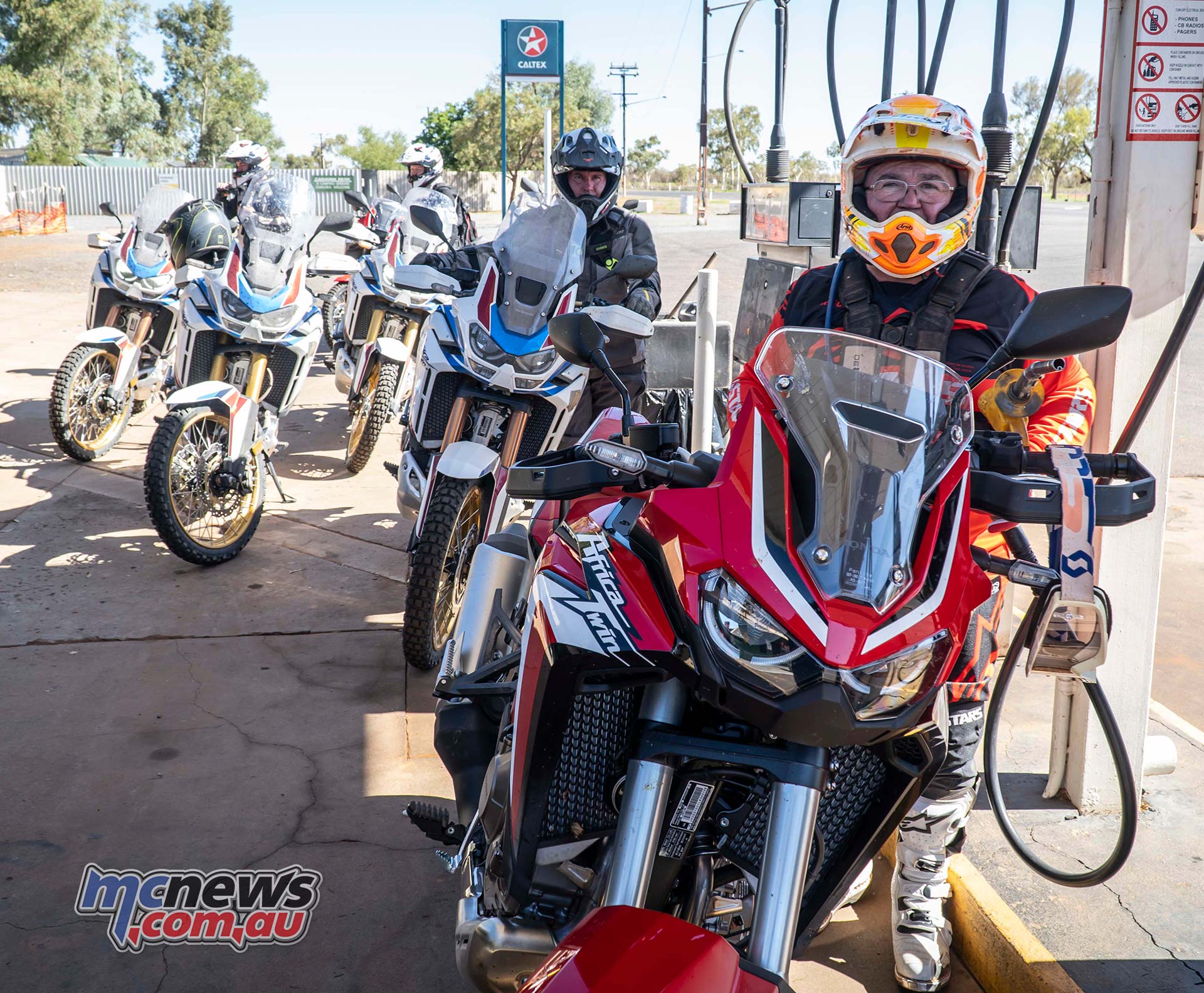
The standard seat can also be set in the 870 mm position for those a little more generously endowed of leg, while an optional high seat pushes the perch further up to 895 mm. An optional low-seat pushes the perch down to only 825 mm, without losing any of that ground clearance or suspension travel.
Overall the cockpit is a pleasant place to spend time. That gorgeous colour display is standard across all models and while the Adventure Sports scores a much taller five-stage adjustable windscreen, opinion was split as to whether that was actually an advantage. I spent 95 per cent of my time on the Adventure Sports and only the last 100 km or so on the smaller bike thus don’t feel qualified to make a convincing call either way.
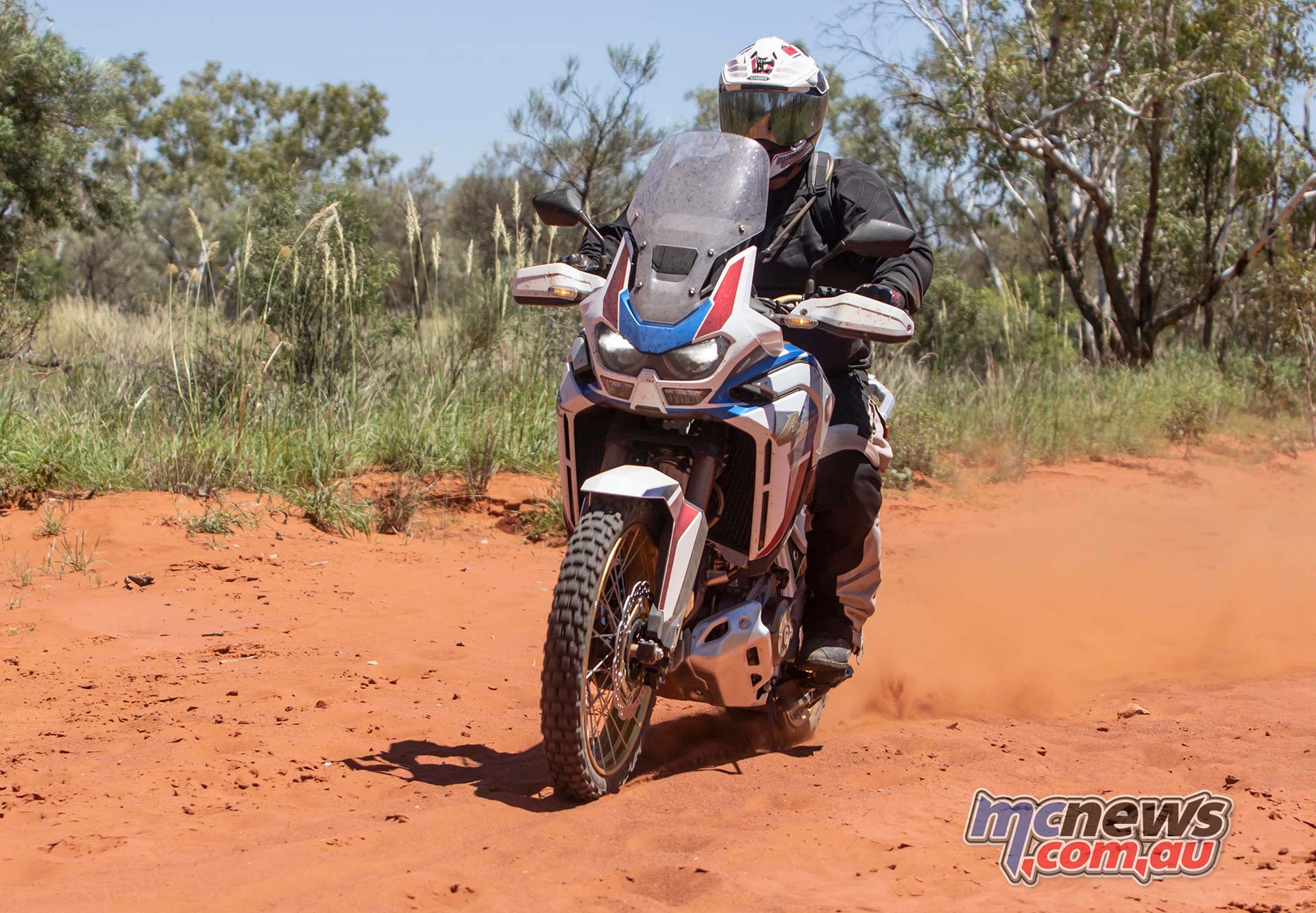
If in your mind light is always right then the more minimalist base model with its slimmer 18.8-litre fuel cell has a 14-kilogram advantage over the Adventure Sports ES. In Australia the base bike can only be had with conventional suspension.
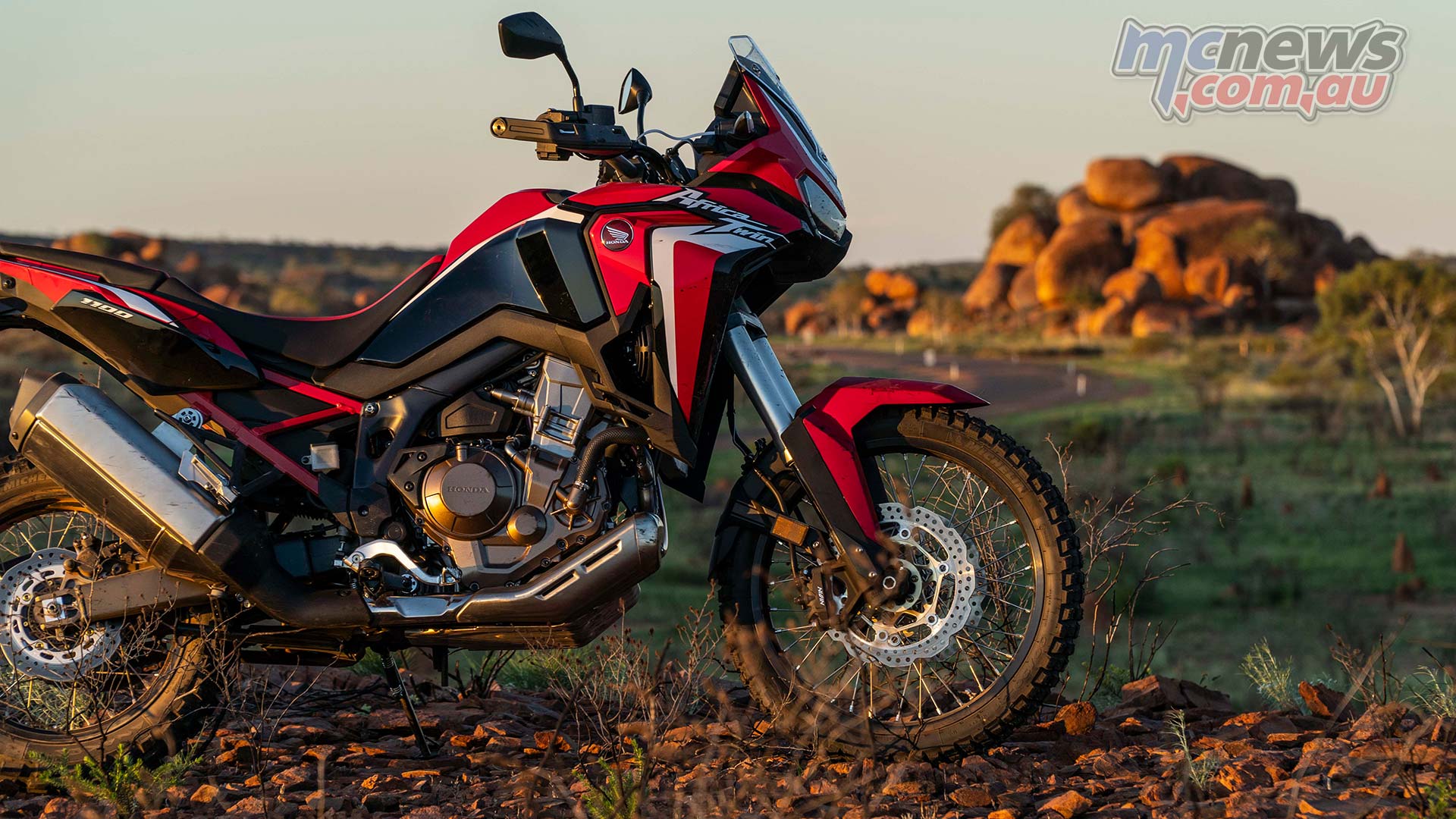
The Adventure Sports boasts a 24.8-litre fuel cell that promises realistic touring ranges in excess of 400 kilometres, even if up it for the rent. It also has more expansive body-work that provides better protection from the elements along with integrated pannier mounts in the rear sub-frame.
I can’t stress enough how important that last feature is for those that like running hard luggage such as the optional aluminium panniers. The difference that having the luggage mounted in tight towards the centre-line can’t be overstated when it comes to the overall dynamics of a machine when fully loaded.
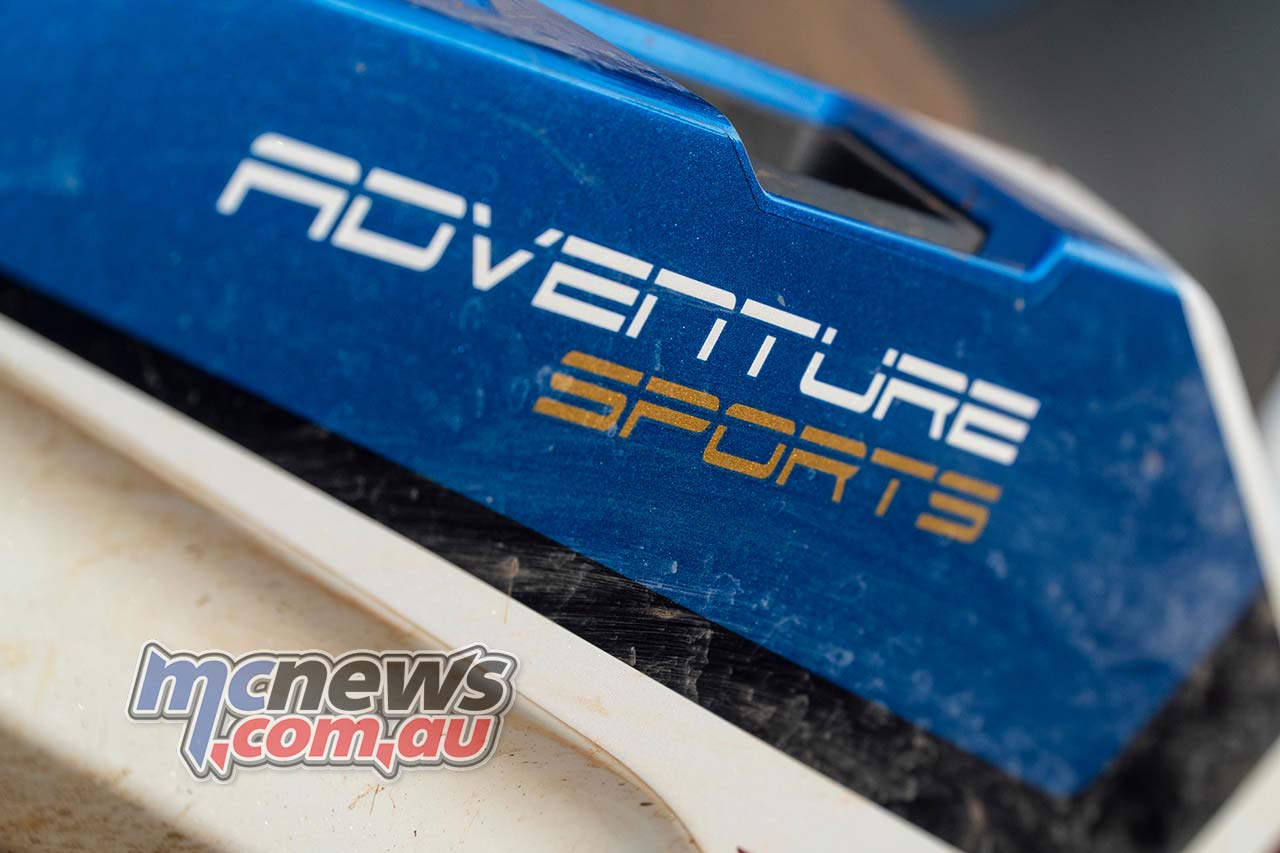
If opting for base model I would consider soft luggage rather than having pannier racks moving all that weight so far out from the bike which, in my experience, turns many bikes into turgid turds. You can fit the integrated mount system from the Adventure Sports though, with the optional rear carrier accessory kit (08L88-MKS-E00) to get the same luggage amenity that is standard on the Adventure Sports.
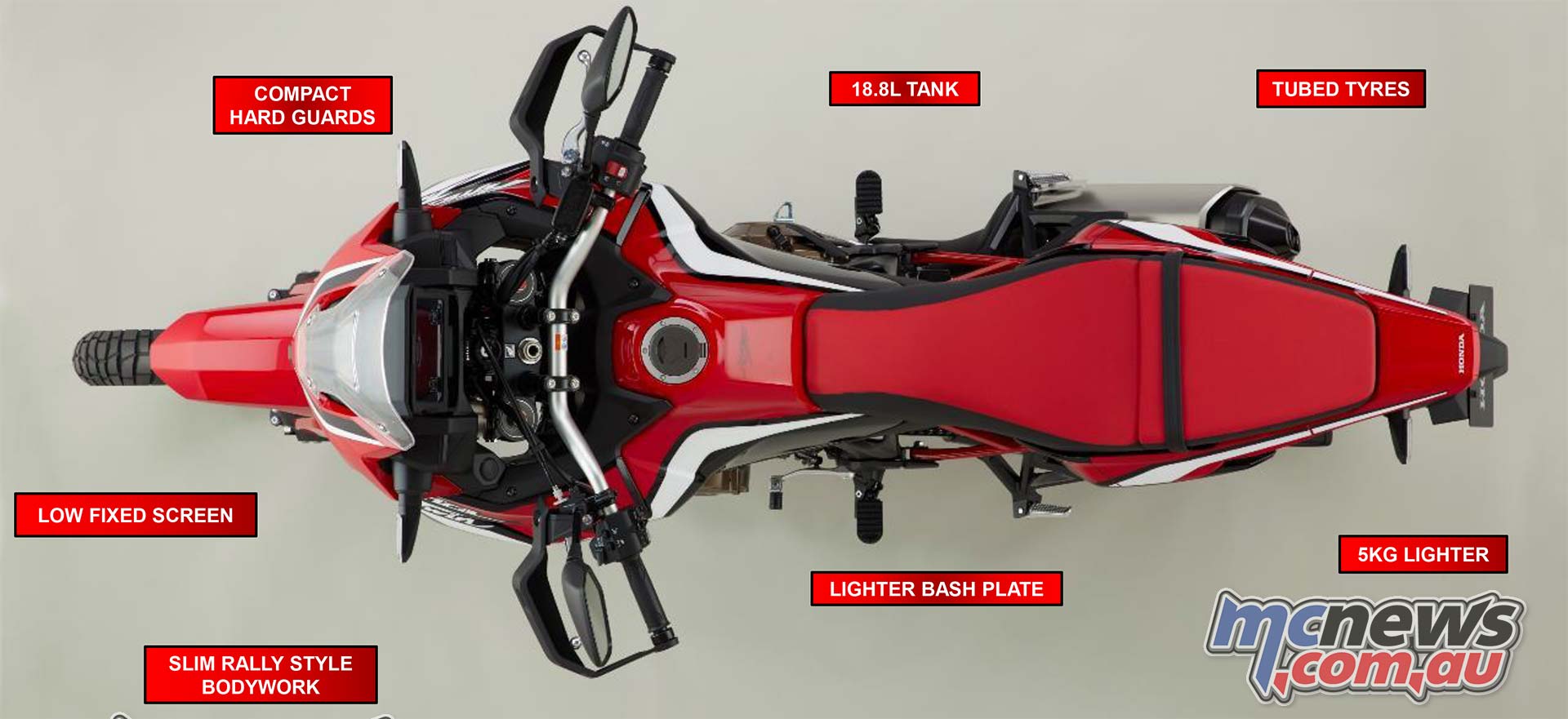
Cruise control is standard on all models but only the Adventure Sports scores factory heated grips and three-stage cornering lights. Tyre pressure monitoring is not available on either model, even as an option, which is a bit of a drawback compared to what is otherwise an impeccable specification list.
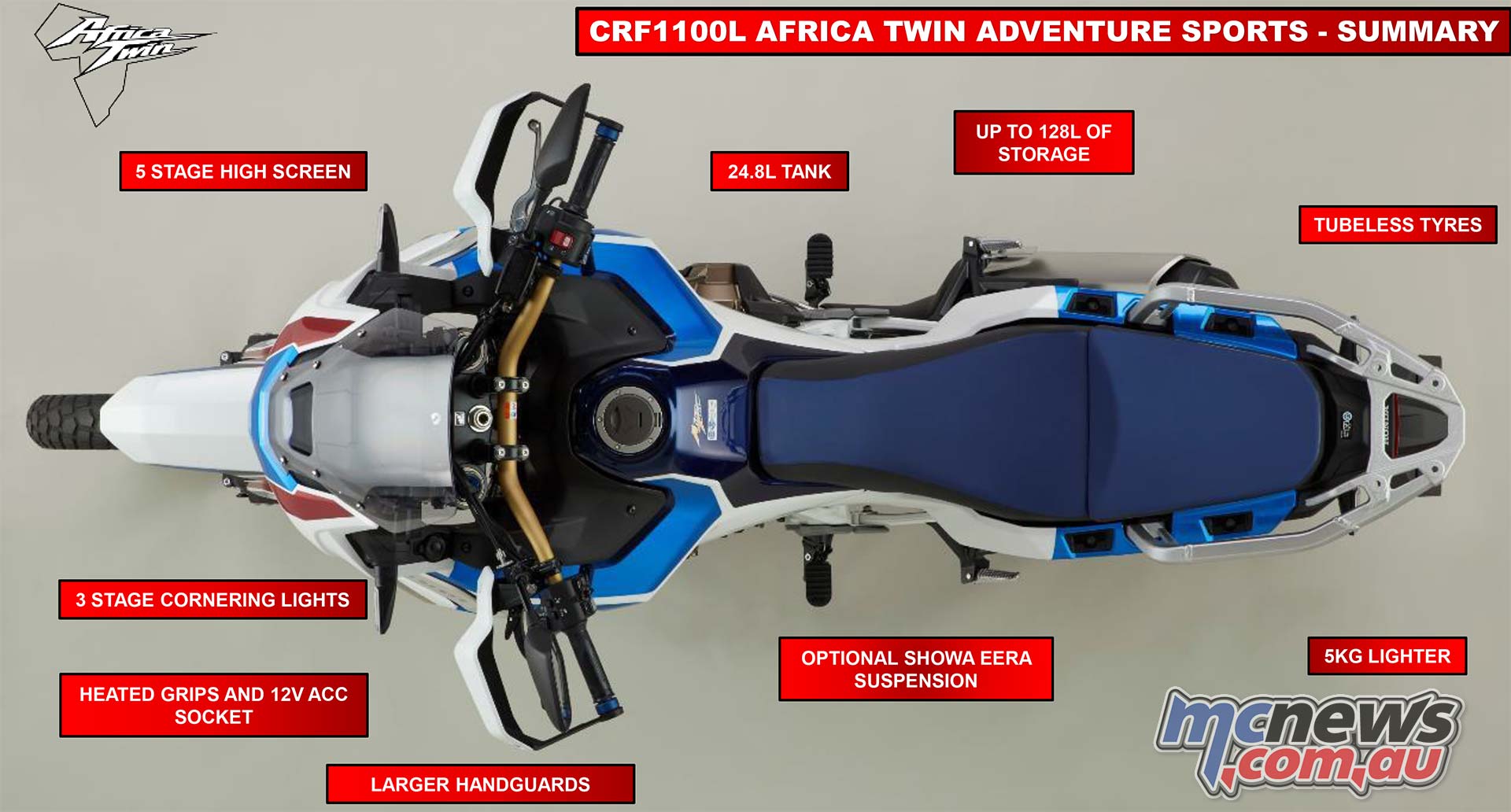
Both bikes have hand-guards as standard with the Adventure Sports guards much larger and offering more wind protection. Neither though are particularly strong and off-road oriented guys would be better off replacing them with proper alloy-bar backed Barkbusters.
The Africa Twin feels very well built and engineered. The bikes never got hot, nothing flapped about or worked loose and I never heard any rattles or squeaks at any point in time. Thus it does exude a certain sense of quality that can be appreciated, and despite the price rises the Africa Twin still offers great value for money and seems pretty damn bullet-proof.
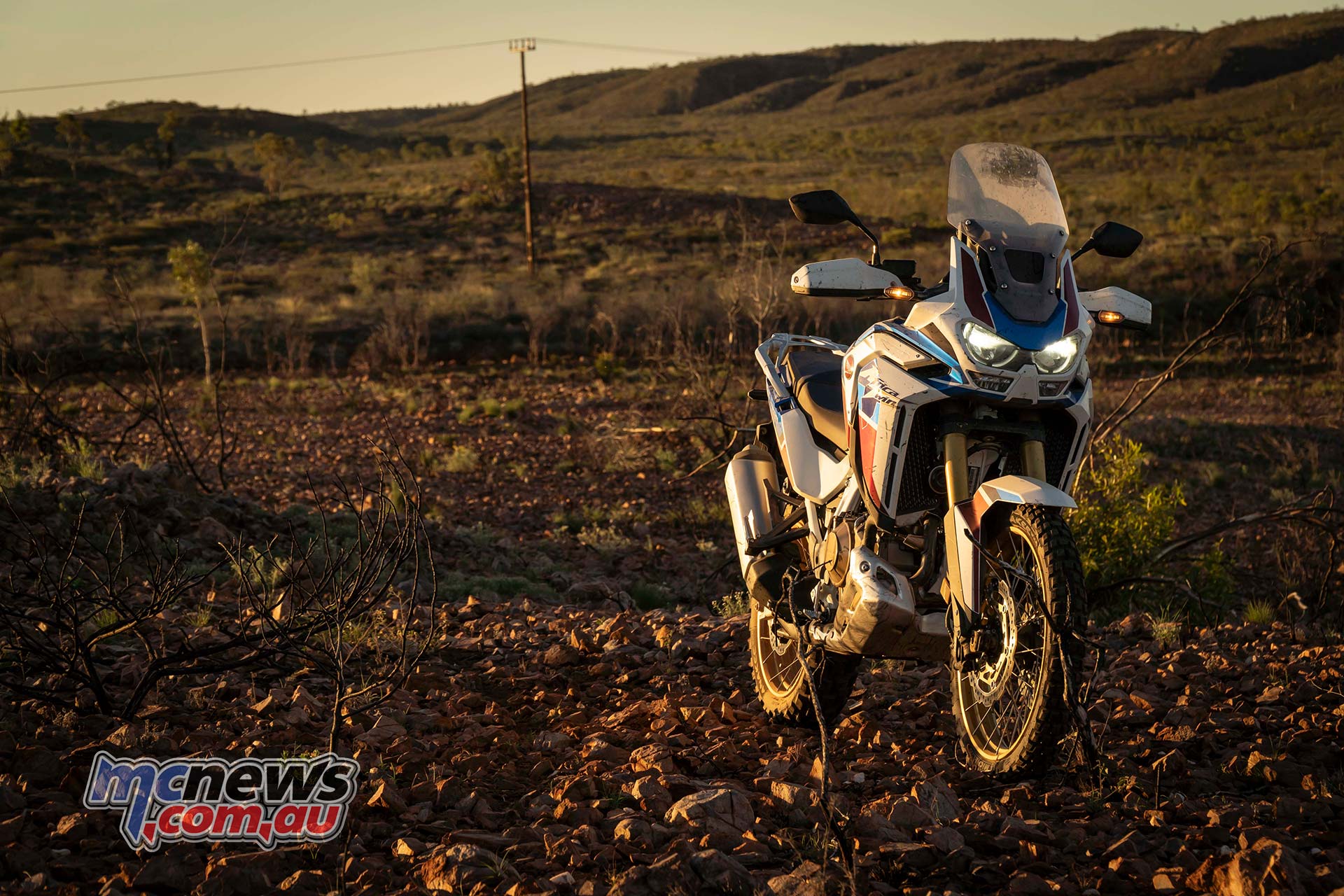
When jumping on the base model manual bike for the last stretch into Alice Springs it definitely felt more lively thanks to its more compact size and reduced weight. That the base bike also has good quality conventional Showa suspension and that brilliant screen, complete with Apple CarPlay as standard, makes its $19,999 price point really look attractive. In Australia this variant of the Africa Twin is not available with the DCT transmission.
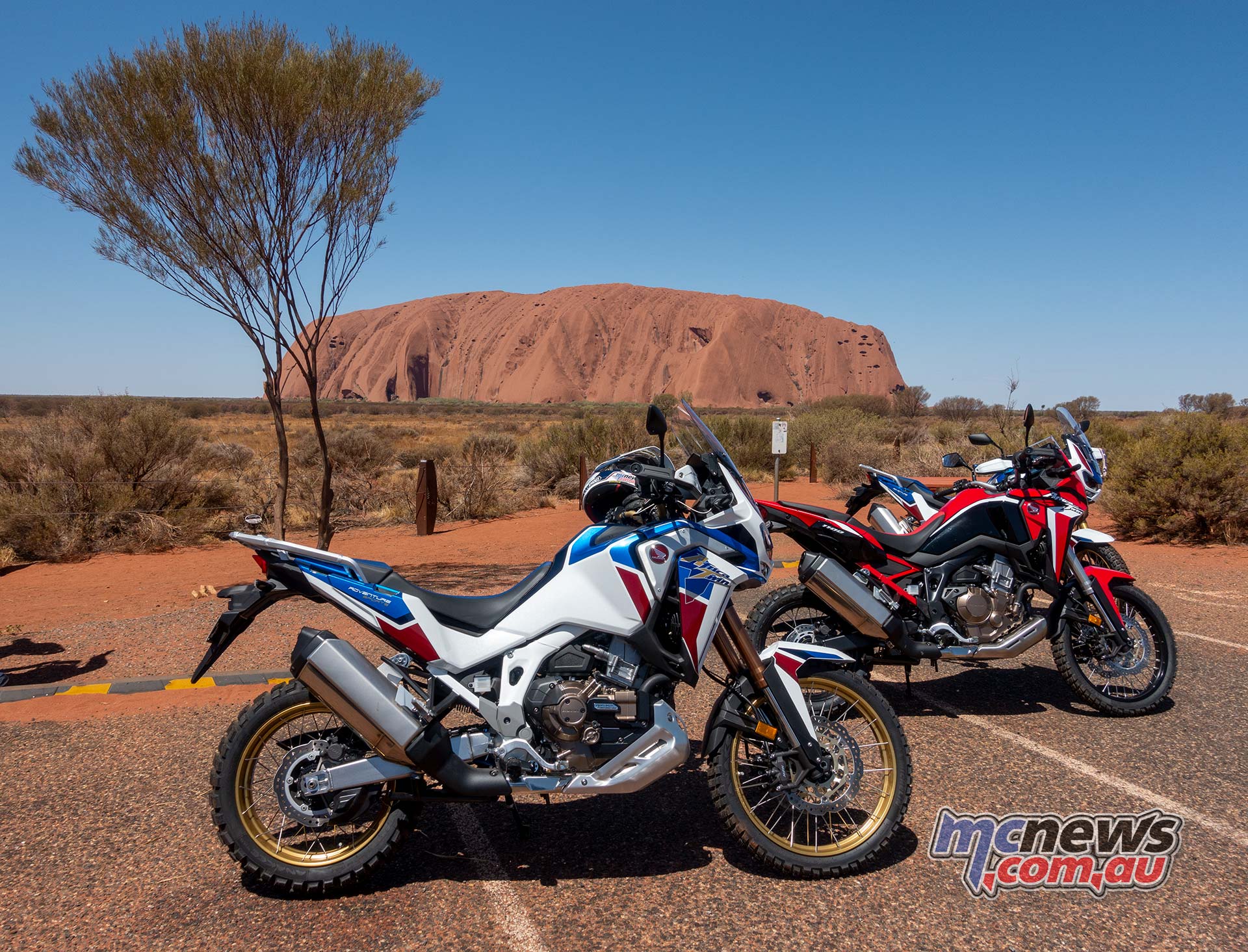
As good as the base bike is, for me I reckon it would be the burger with the lot Adventure Sports that would get my money, if I could stretch the budget that far. The DCT really is a great thing, and is going to make even more sense for open road touring or city commuting. I figure you might as well have the electronic suspenders too while you are at it.
In summary, the 2020 Africa Twin is the most dirt-capable large capacity adventure bike you can buy. Both expert off-road riders or relative novices will really appreciate the off-road chops of the new model, which is now more dirt ready than it ever was, and sets a new standard in regards to off-road performance in this 1000cc+ segment.
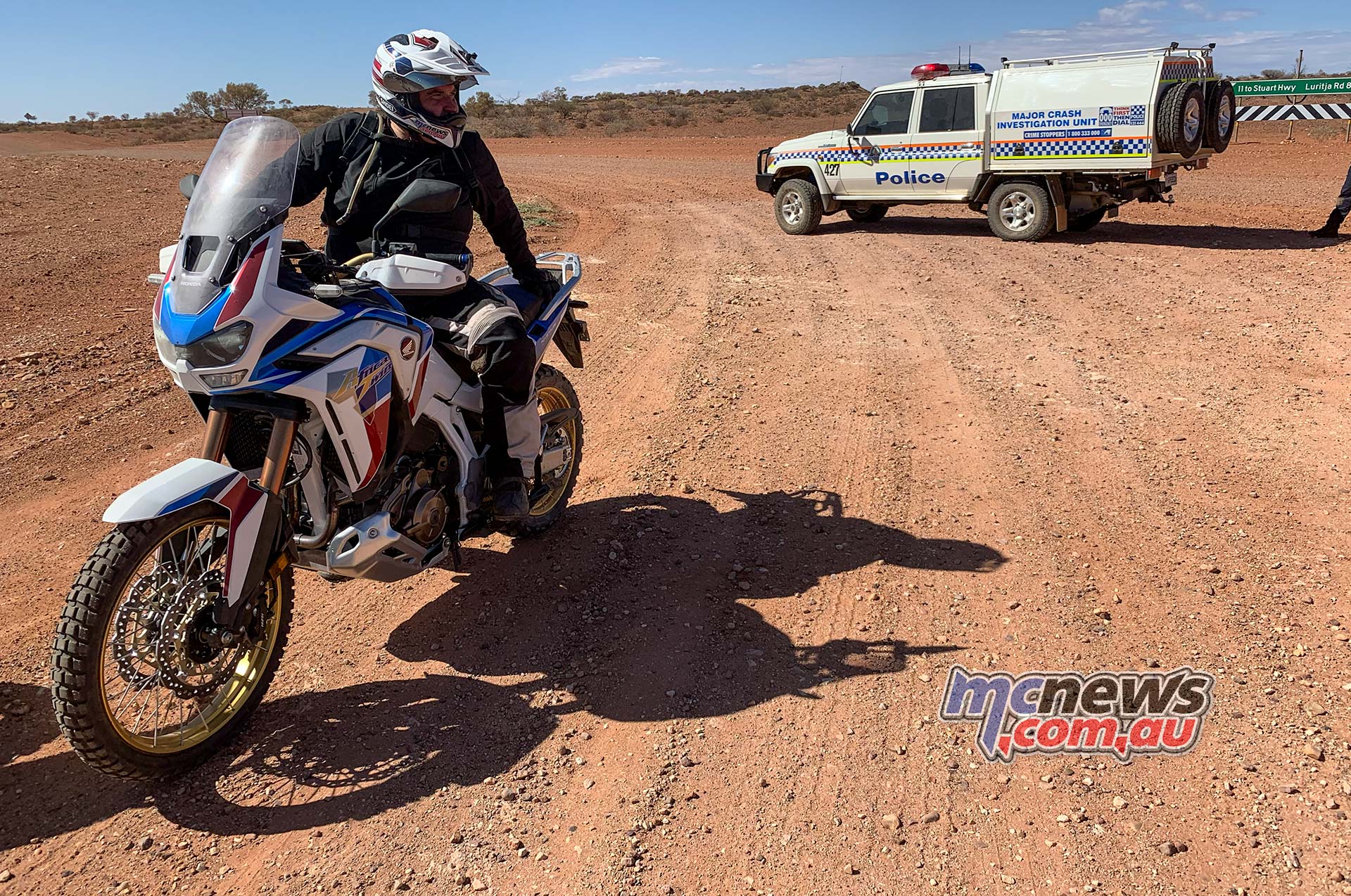
2020 Honda Africa Twin Specifications
| Engine | |
| Type | SOHC liquid-cooled 4-stroke 8-valve parallel twin with 270° crank and Uni-cam |
| Displacement | 1084 cc |
| Bore & Stroke | 92 mm x 81.5 mm |
| Compression Ratio | 10.1:1 |
| Power | 75kW at 7,500rpm |
| Torque | 105Nm at 6,250rpm |
| Noise Level | 73dB |
| Oil Capacity | 4.8/4.3 (5.2/4.7 DCT) |
| Fuel System | |
| Carburation | PGM-FI |
| Fuel Capacity | 18.8L |
| CO2 Emissions | 112g/km MT 110g/km DCT |
| Fuel Consumption | 4.9L/100km (20.4km/L) MT 4.8L/100km (20.8km/L) DCT |
| Electrical System | |
| Starter | Electric |
| Battery Capacity | 12V-6Ah Li-ion battery (20hr) |
| ACG Output | 0.49 kW/5,000rpm |
| Drivetrain | |
| Clutch Type | Wet, multiplate with coil springs, aluminium cam assist and slipper clutch DCT – 2 wet multiplate clutches with coil springs |
| Transmission Type | 6 speed manual (6 speed DCT) |
| Frame | |
| Type | Semi double cradle |
| Chassis | |
| Dimensions (L´W´H) | 2330 mm x 960 mm x 1395 mm |
| Wheelbase | 1575 mm |
| Caster Angle | 27.5° |
| Trail | 113 mm |
| Seat Height | 850/870 mm (low seat option 825 mm, high seat option 895mm) |
| Ground Clearance | 250 mm |
| Kerb Weight | 226 kg (DCT 236 kg) |
| Suspension | |
| Front | Showa 45mm cartridge-type inverted telescopic fork with dial-style preload adjuster and DF adjustments, 204 mm travel |
| Rear | Monoblock aluminium swing arm with Pro-Link with Showa gas-charged damper, hydraulic dial-style preload adjuster and rebound damping adjustments, 220 mm rear wheel travel |
| Wheels | |
| Front Wheel | 21″ M/C x 2.15 wire spoke with aluminium rim |
| Rear Wheel | 18″ M/C x MT4.00 wire spoke with aluminium rim |
| Front Tyre | 90/90-21M/C 54H (tube type) (Bridgestone Battlax Adventurecross Tourer AX41T / Metzeler Karoo Street) |
| Rear Tyre | 150/70R18M/C 70H (tube type) (Bridgestone Battlax Adventurecross Tourer AX41T / AX41T Metzeler Karoo Street) |
| Brakes | |
| ABS System Type | 2 channel with IMU Selectable ABS MODE with on-road and off-road setting |
| Front Brakes | 310 mm dual wave floating hydraulic disc with aluminium hub and radial fit 4-piston calipers and sintered metal pads |
| Rear Brakes | 256 mm wave hydraulic disc with single piston caliper and sintered metal pads. 2 channel with rear ABS OFF mode. |
| Instruments & Electronics | |
| Instruments | LCD Meter, TFT 6.5inch touch panel multi information display |
| Security System | Immobiliser, security alarm (optional) |
| Headlight/Taillight | LED |
| Electrics | Daytime running lights, Bluetooth audio and Apple Carplay, USB socket, auto turn signal cancel, cruise control, emergency stop signal, IMU, HSTC and wheelie control) |
| Engine | |
| Type | SOHC liquid-cooled 4-stroke 8-valve parallel twin with 270° crank and Uni-cam |
| Displacement | 1084 cc |
| Bore & Stroke | 92 mm x 81.5 mm |
| Compression Ratio | 10.1:1 |
| Power | 75 kW at 7500 rpm |
| Torque | 105 Nm at 6250 rpm |
| Noise Level | 73 dB |
| Oil Capacity | 4.8/4.3 (5.2/4.7 DCT) |
| Fuel System | |
| Carburation | PGM-FI |
| Fuel Tank Capacity | 24.8 L |
| CO2 Emissions | 112g/km MT 110g/km DCT |
| Fuel Consumption | 4.9L/100 km (20.4 km/L) MT 4.8L/100 km (20.8 km/L) DCT |
| Electrical System | |
| Starter | Electric |
| Battery Capacity | 12V-6Ah Li-ion battery (20hr) |
| ACG Output | 0.49 kW/5000 rpm |
| Drivetrain | |
| Clutch Type | Wet, multiplate with coil springs, aluminium cam assist and slipper clutch DCT – 2 wet multiplate clutches with coil springs |
| Transmission Type | 6 speed manual (6 speed DCT) |
| Frame | |
| Type | Semi double cradle |
| Chassis | |
| Dimensions (L´W´H) | 2330 mm x 960 mm x 1560 mm (1620 mm with screen in uppermost position) |
| Wheelbase | 1575 mm |
| Caster Angle | 27.5° |
| Trail | 113 mm |
| Seat Height | 850/870 mm (low seat option 825 mm, high seat option 895 mm) |
| Ground Clearance | 250 mm |
| Kerb Weight | 238 kg (DCT 248 kg) With Showa EERA 240 kg MT (DCT 250 kg) |
| Suspension | |
| Front | Showa 45mm cartridge-type inverted telescopic fork with dial-style preload adjuster and damping adjustment, 204 mm stroke / EERA – Showa Telescopic inverted fork with an inner tube diameter of 45 mm, and Showa EERA with compression and rebound damping adjustments, 204 mm stroke |
| Rear | Monoblock aluminium swing arm with Pro-Link with Showa gas-charged damper, hydraulic dial-style preload adjuster and rebound damping adjustments, 220 mm rear wheel travel. / EERA – Monoblock aluminium swing arm with Pro-Link with Showa gas-charged damper, hydraulic remote control preload adjuster and electric control unit with compression and rebound damping adjustments, 220 mm rear wheel travel |
| Wheels | |
| Front Wheel | 21″ M/C x MT2.15 wire spoke with aluminium rim |
| Rear Wheel | 18″ M/C x MT4.00 wire spoke with aluminium rim |
| Front Tyre | 90/90-21M/C 54H (tubeless type) Bridgestone Battlax Adventurecross Tourer AX41T Metzeler Karoo Street |
| Rear Tyre | 150/70R18M/C 70H (tubeless type) Bridgestone Battlax Adventurecross Tourer AX41T Metzeler Karoo Street |
| Brakes | |
| ABS System Type | 2 channel with IMU Selectable ABS MODE with on-road and off-road setting |
| Front Brakes | 310 mm dual wave floating hydraulic disc with aluminium hub and radial fit 4-piston calipers and sintered metal pads |
| Rear Brakes | 256 mm wave hydraulic disc with single piston caliper and sintered metal pads. 2-Channel with rear ABS off mode. |
| Instruments & Electronics | |
| Instruments | LCD Meter, TFT 6.5 inch touch panel multi information display |
| Security System | Immobiliser, security alarm (optional) |
| Headlight/Taillight | LED |
| Electrics | Daytime running lights, Bluetooth audio and Apple® CarPlay, USB socket, auto turn signal cancel, cruise control, emergency stop signal, IMU, HSTC, cornering lights, wheelie control |
